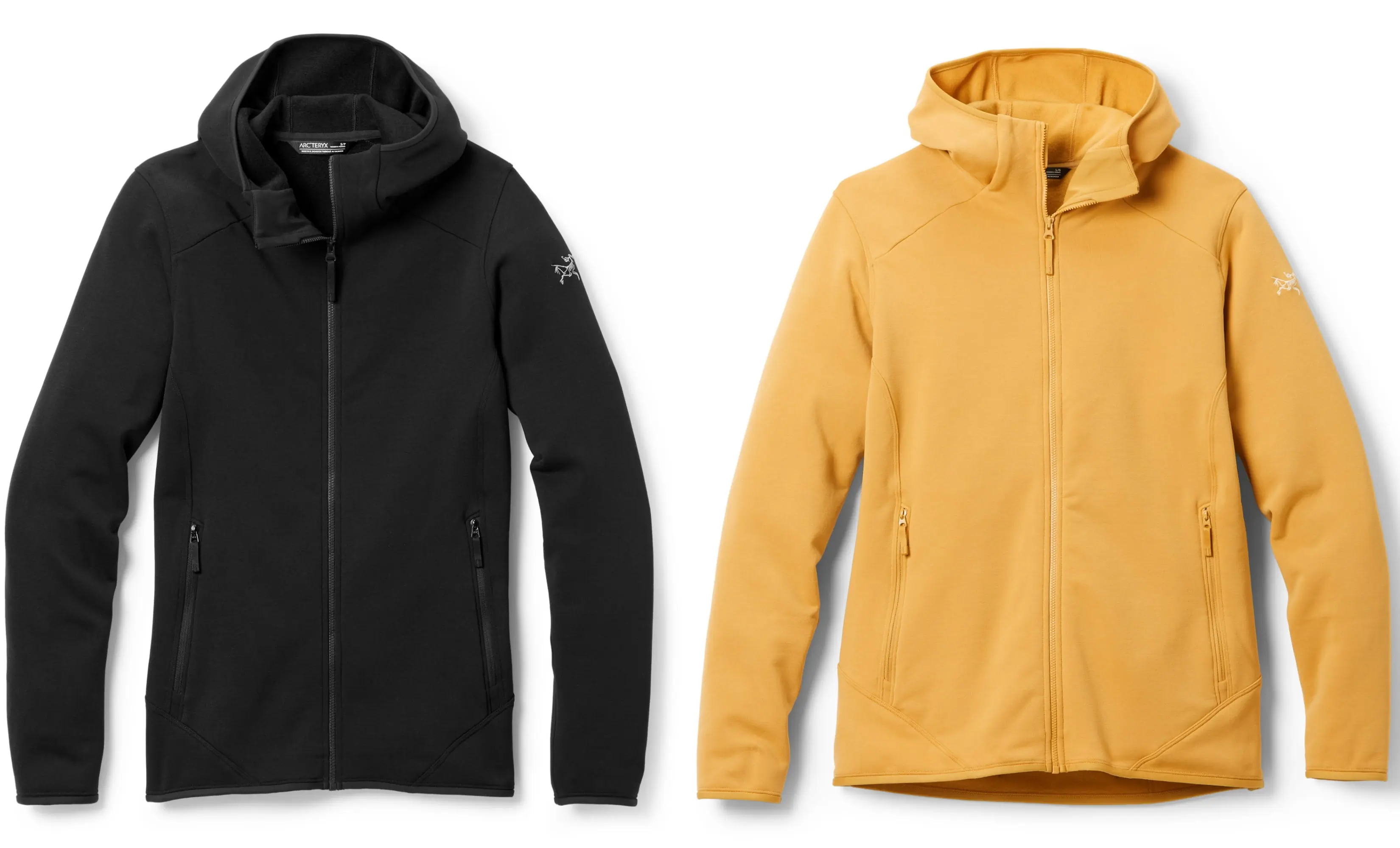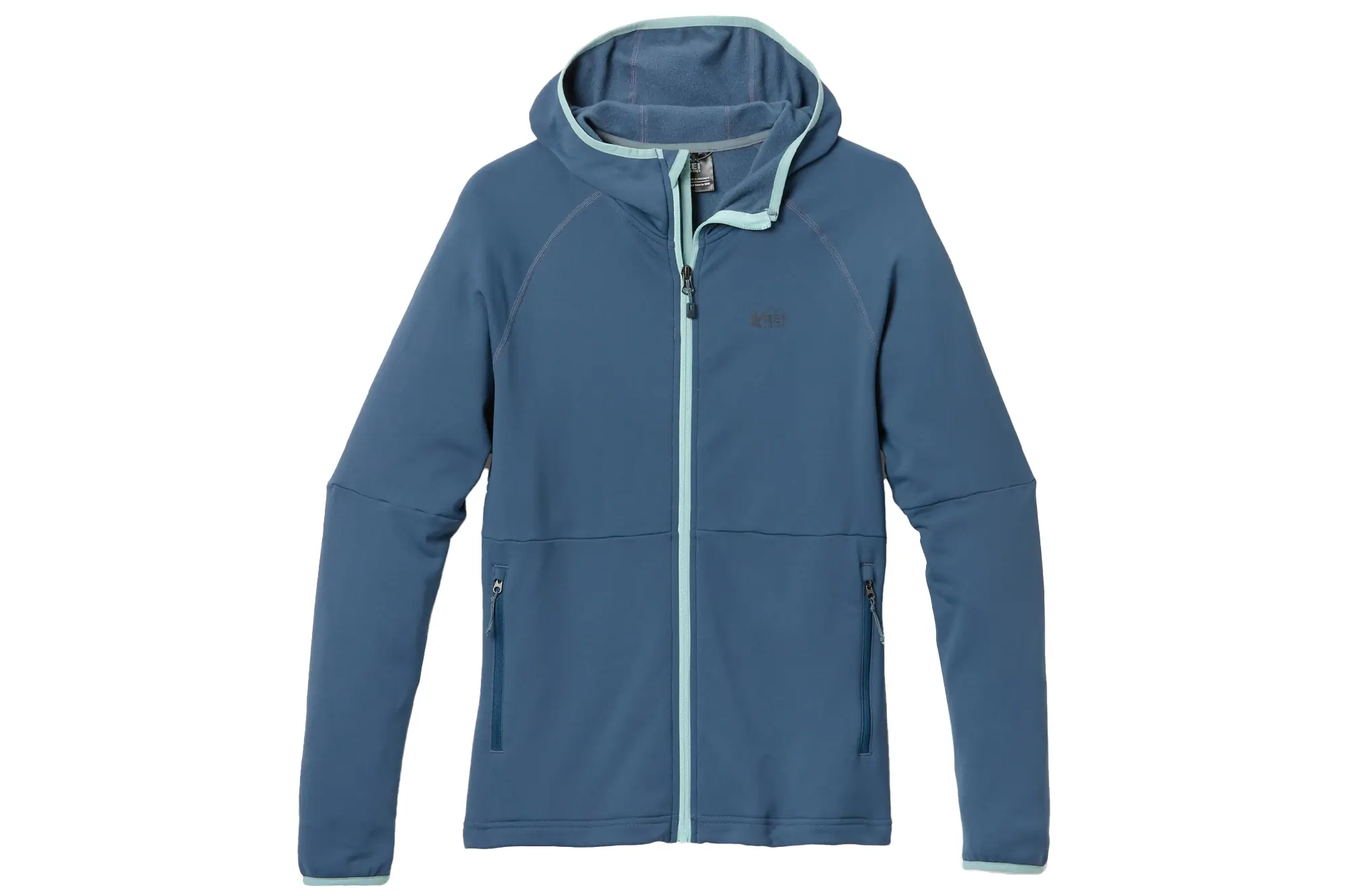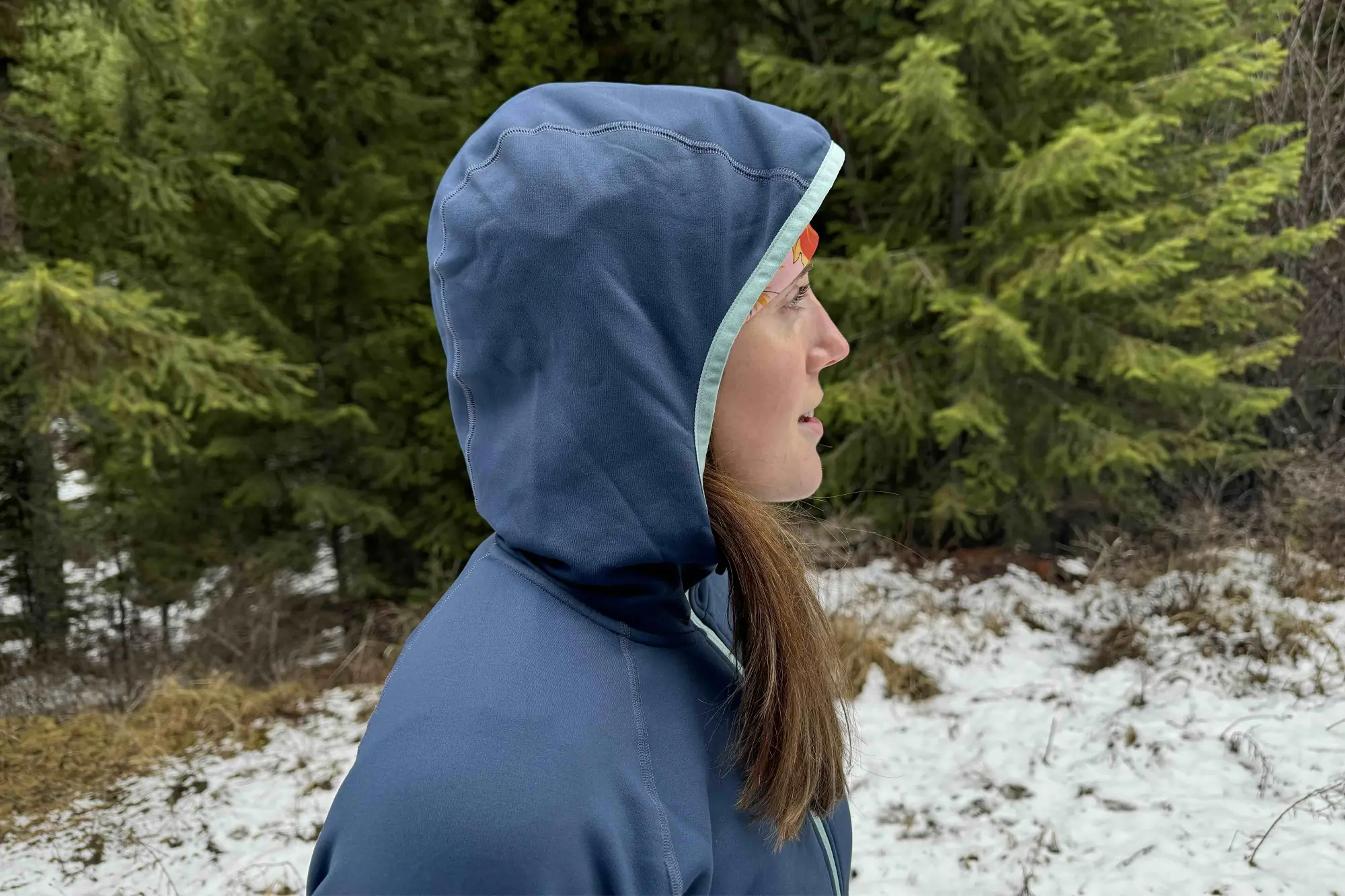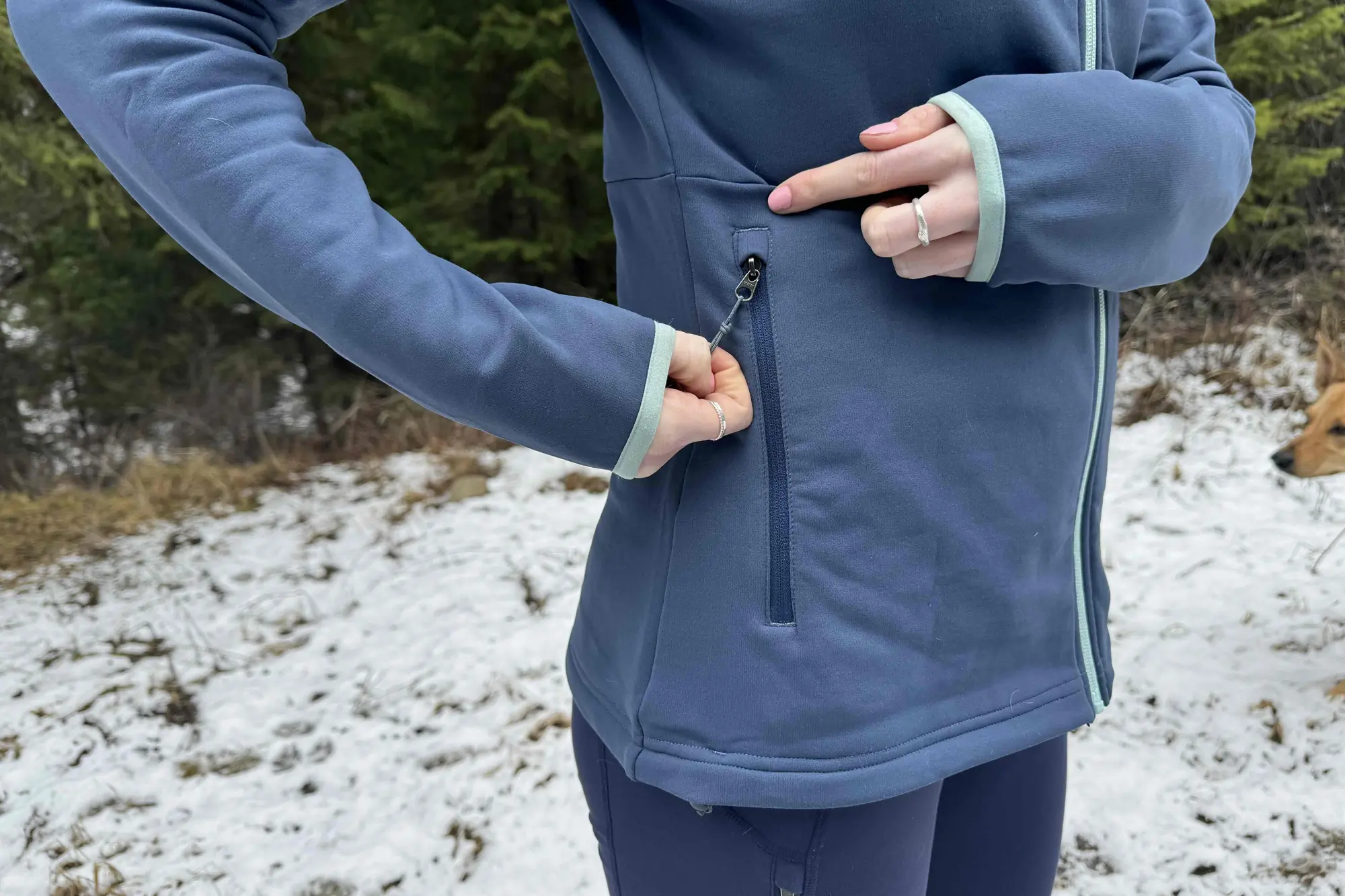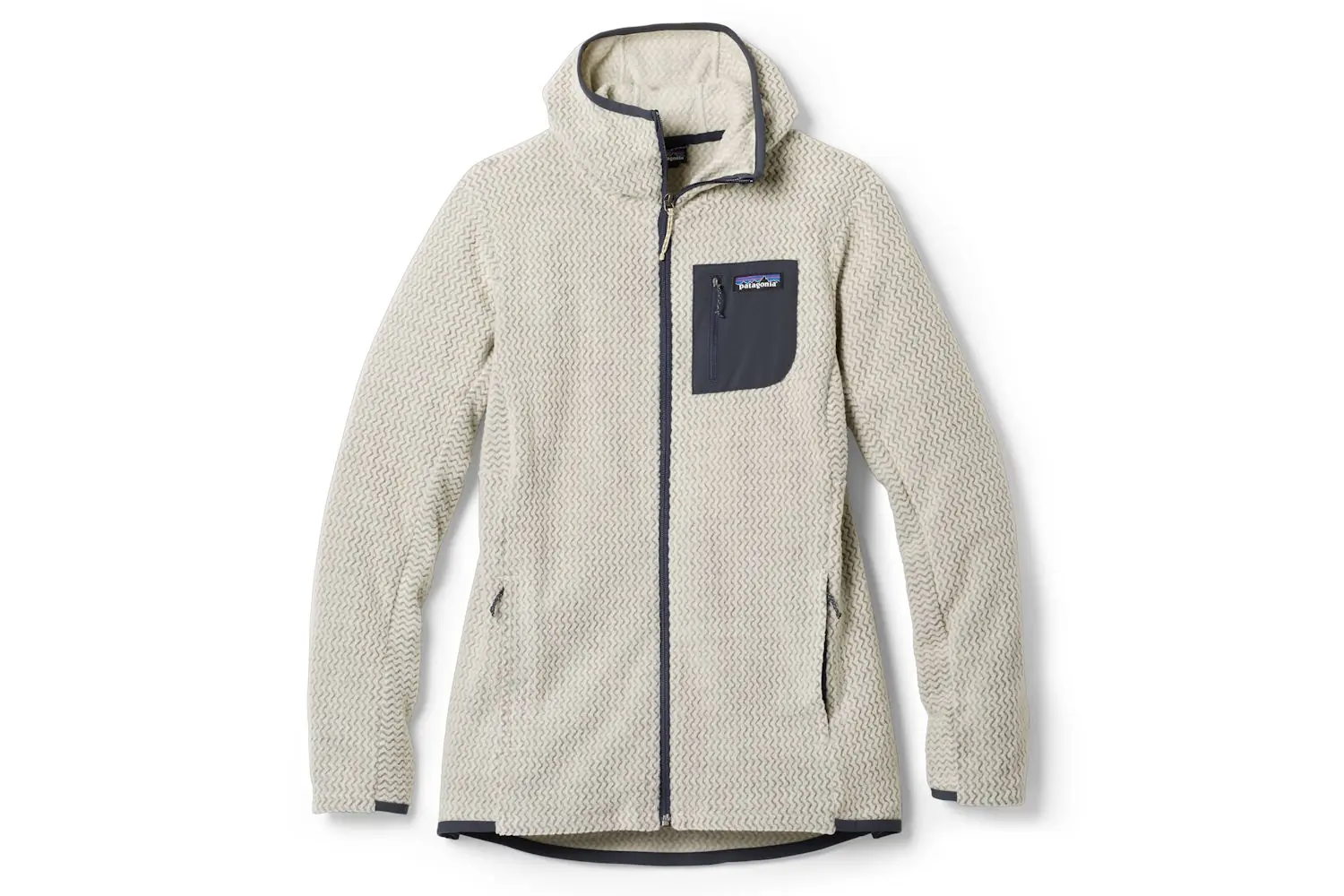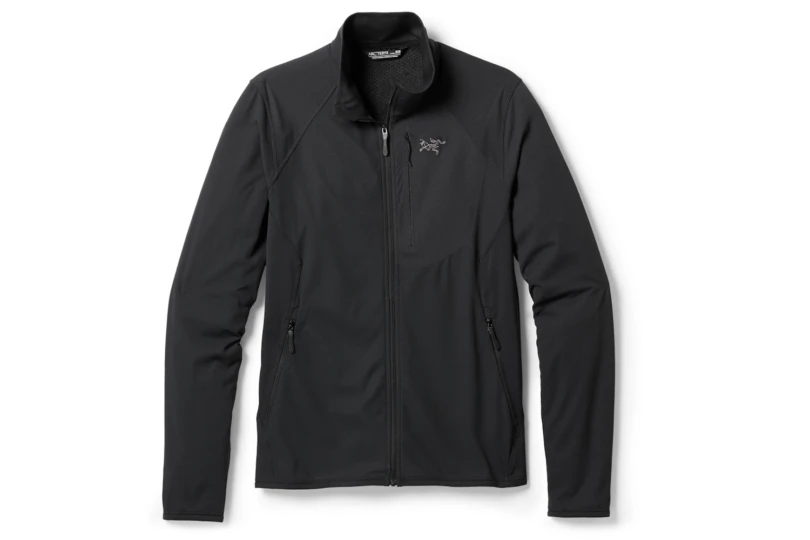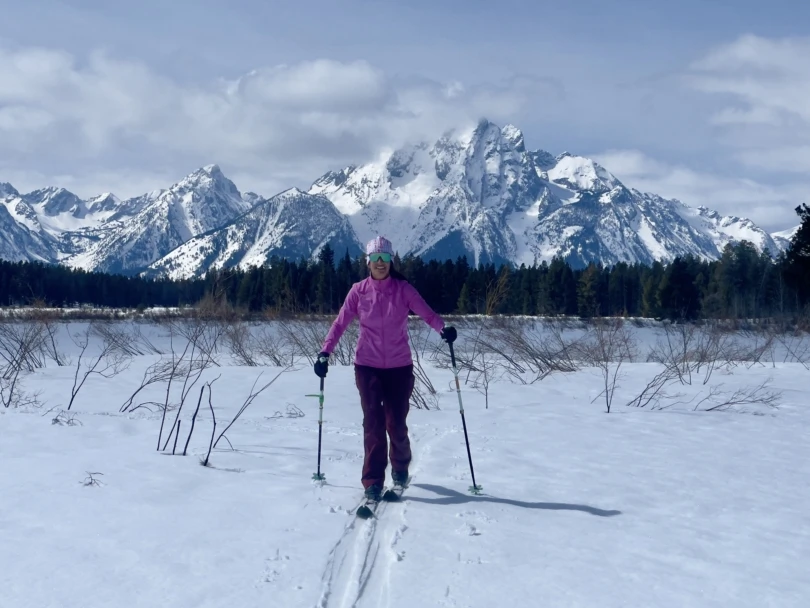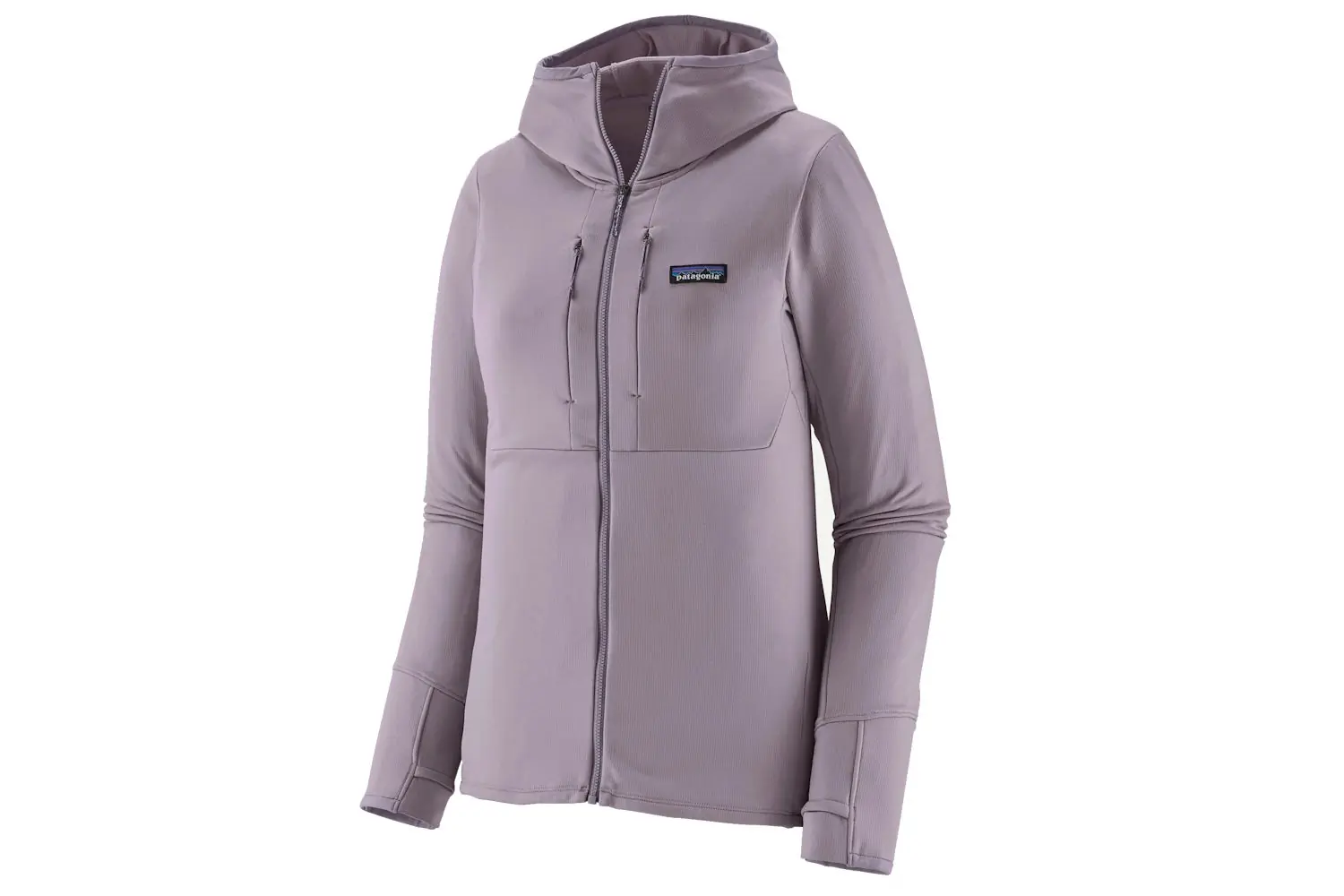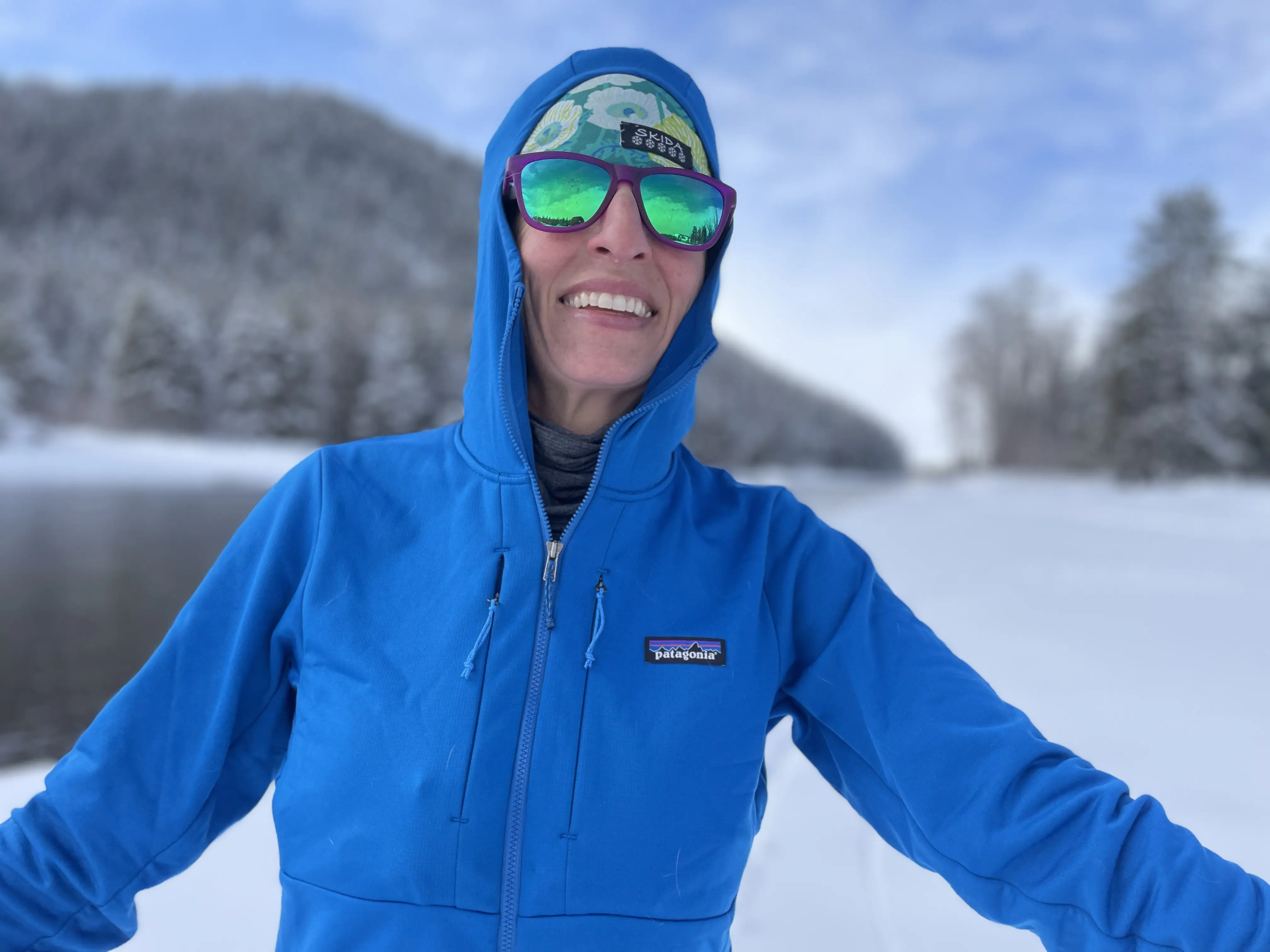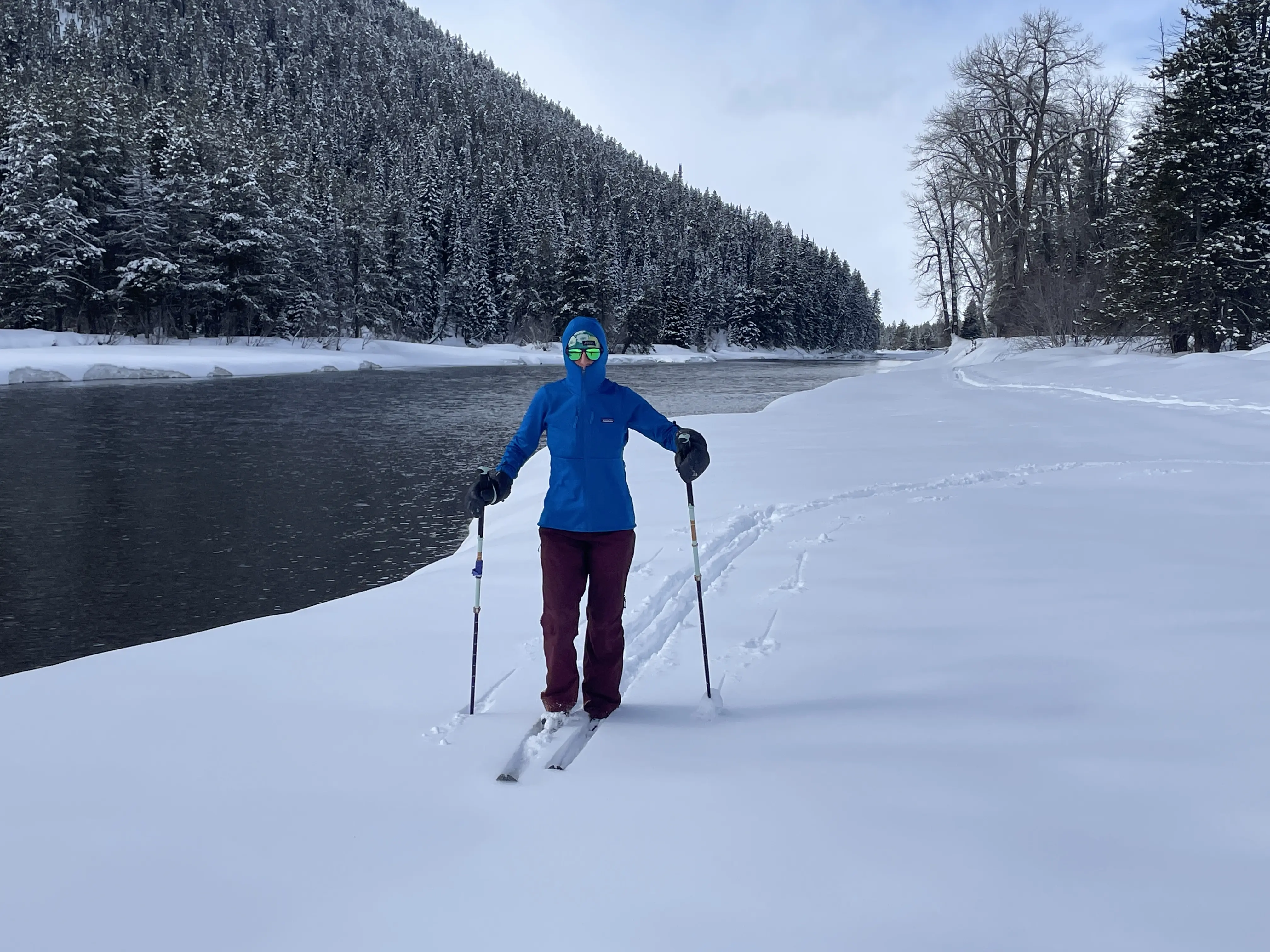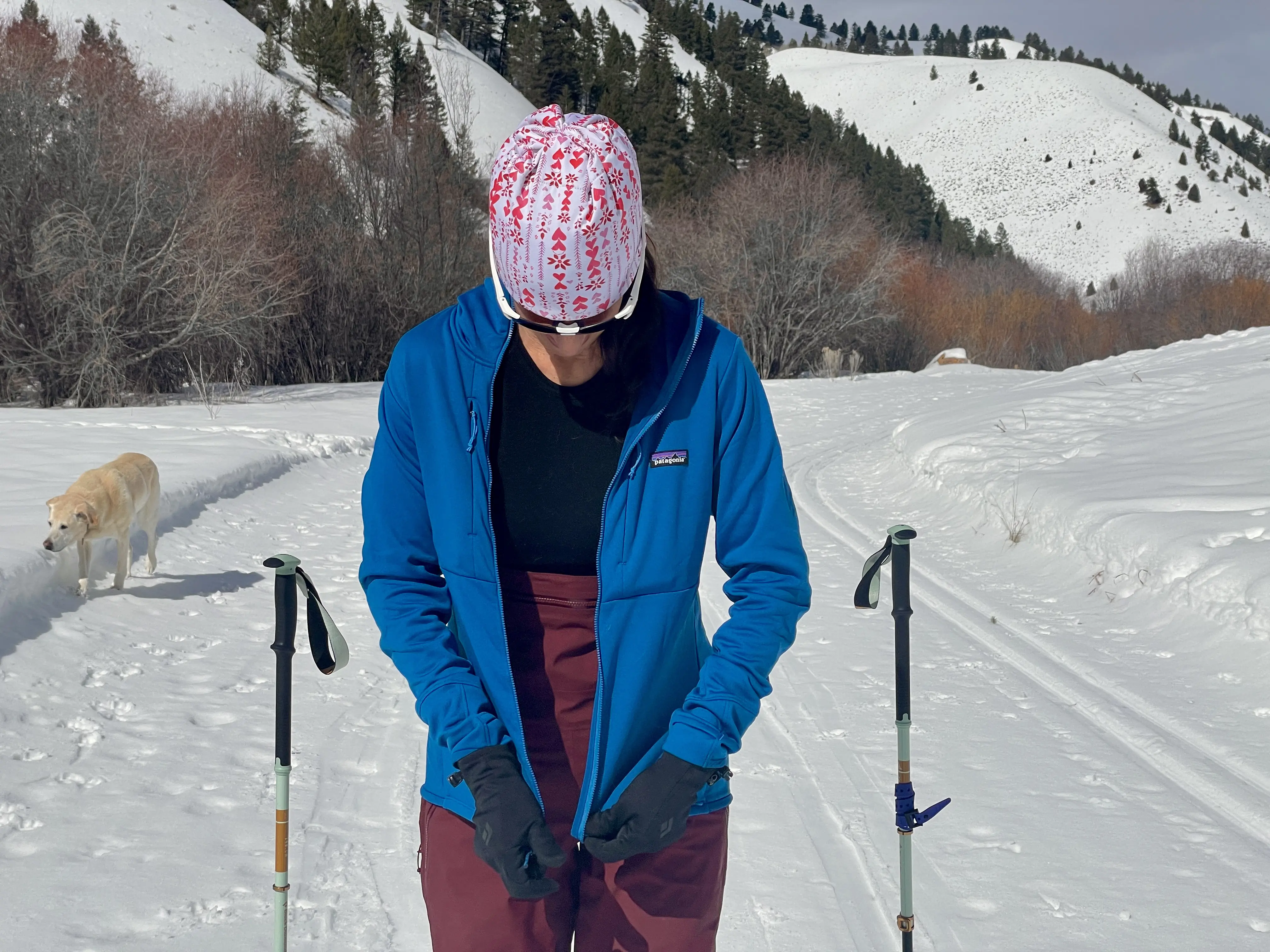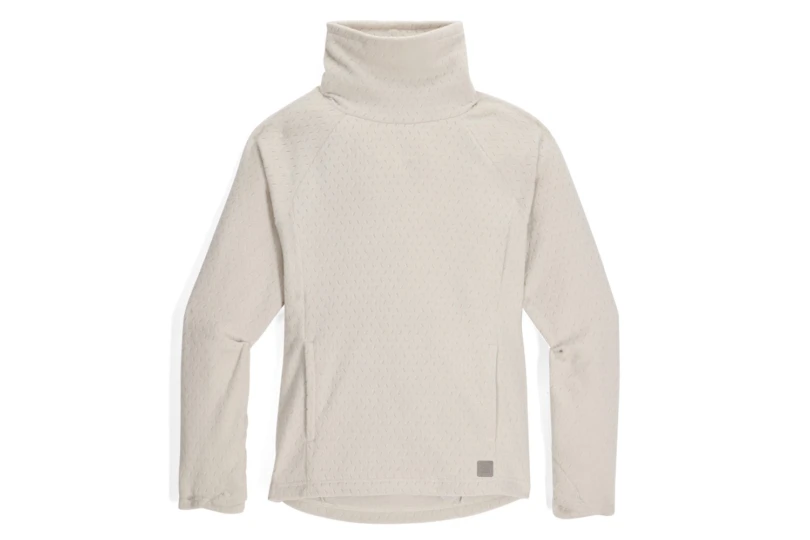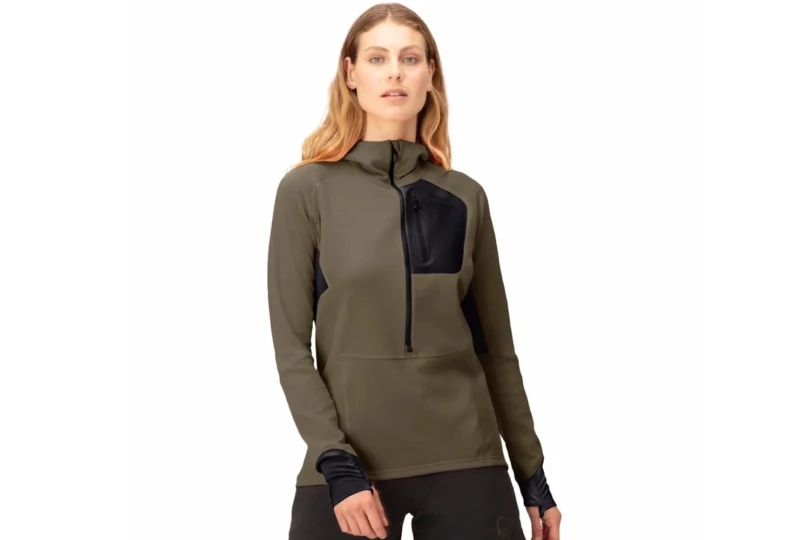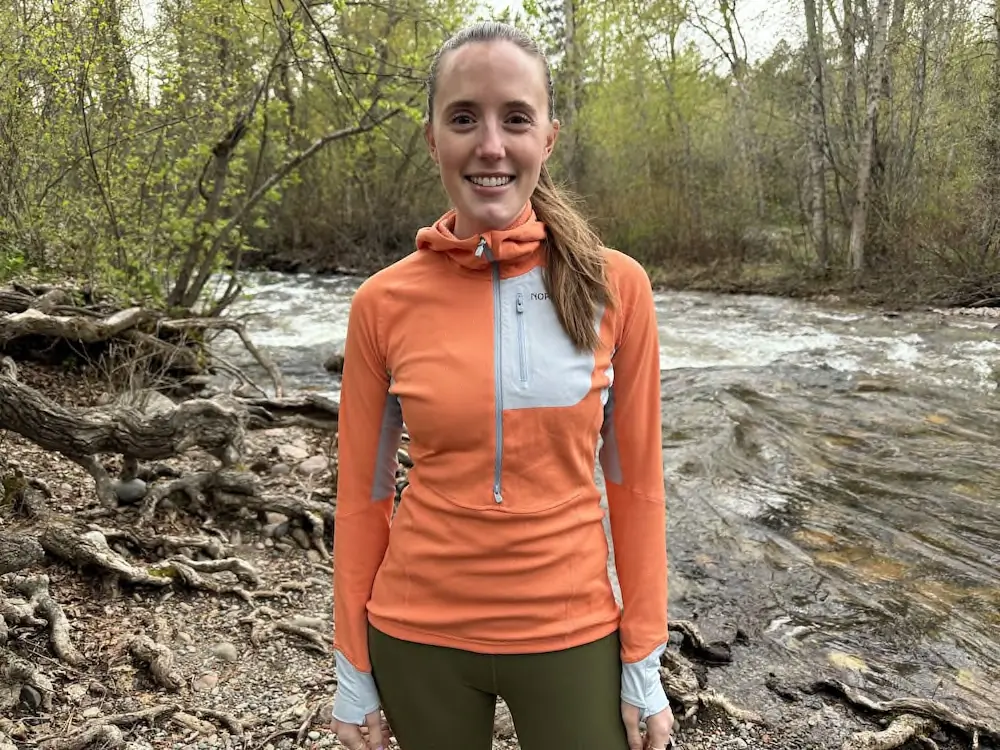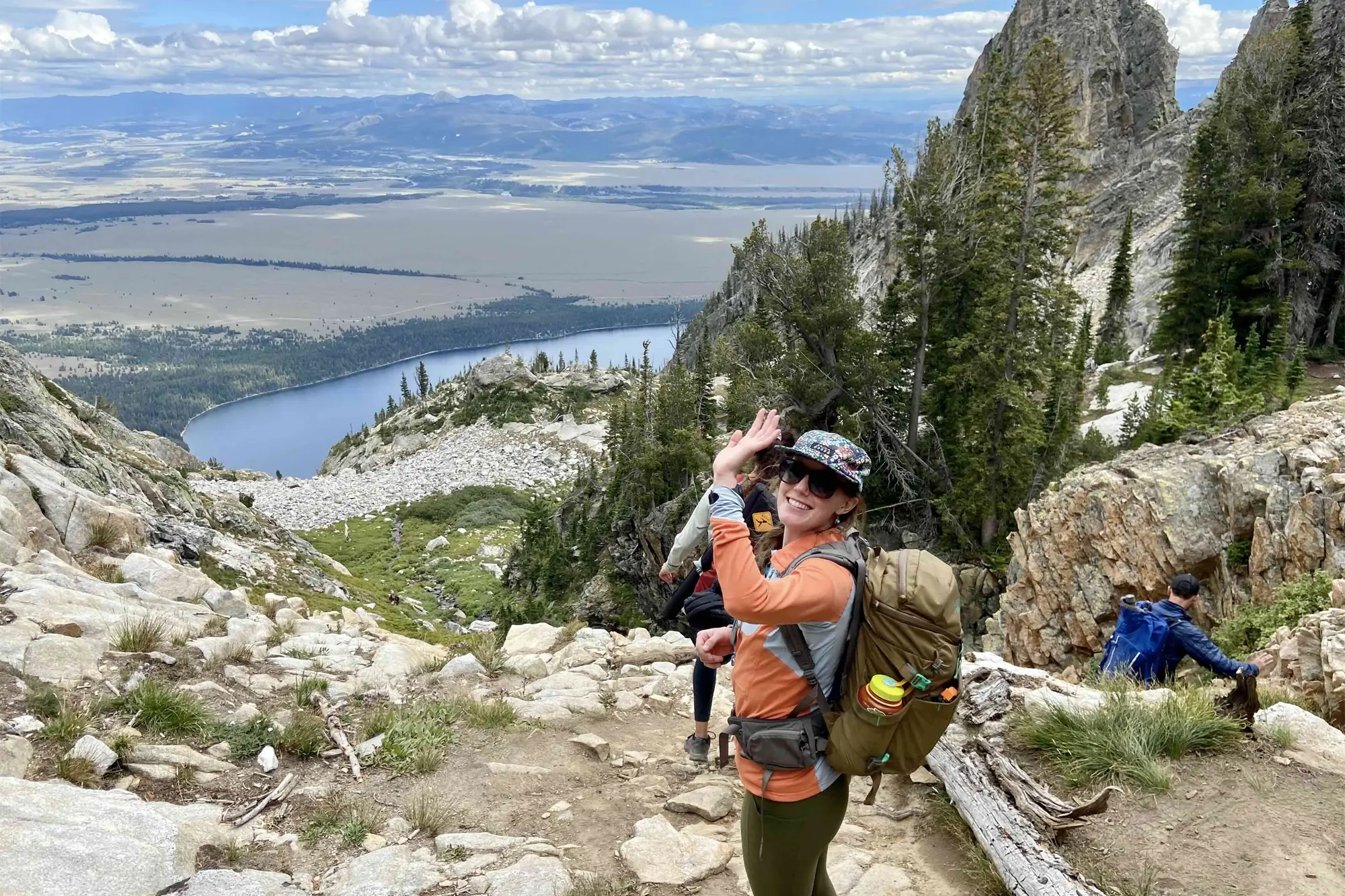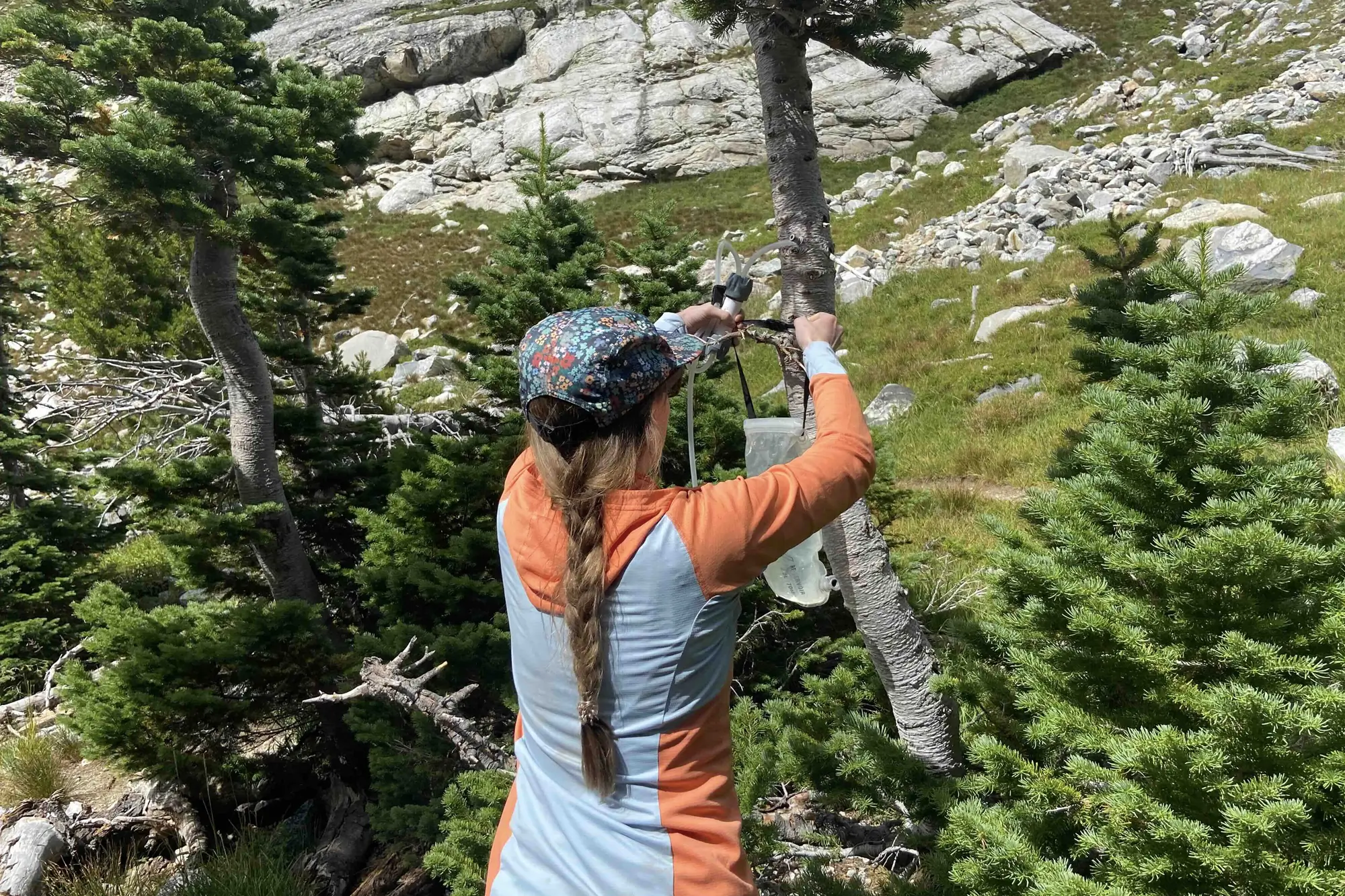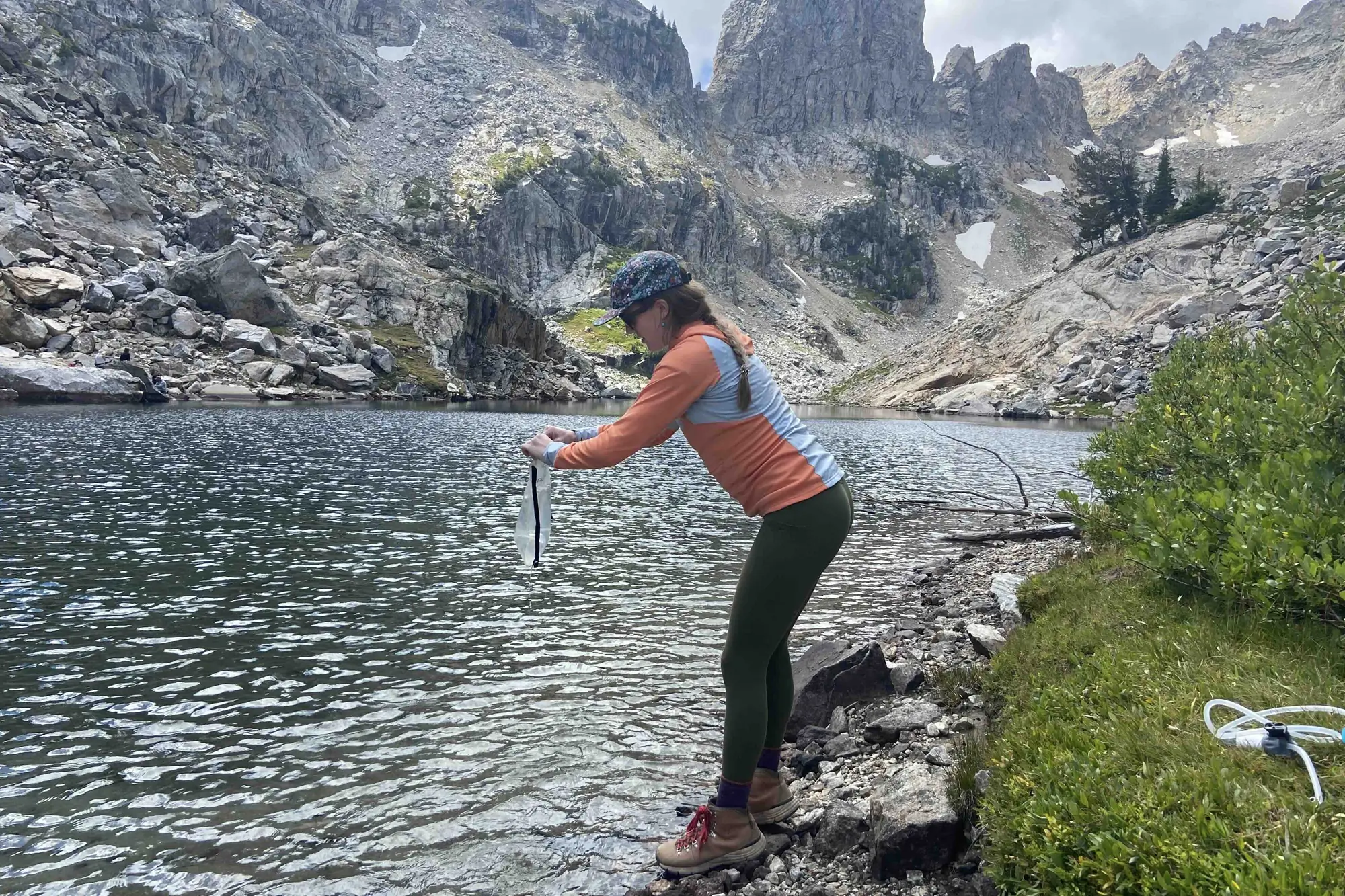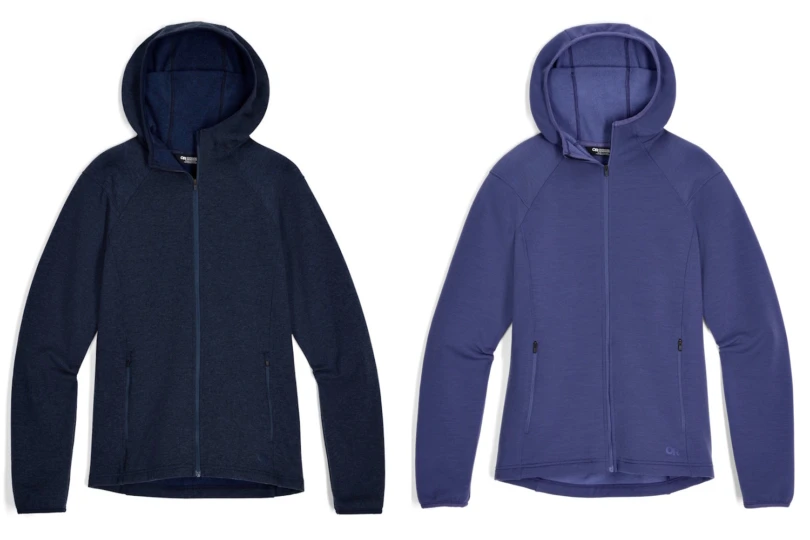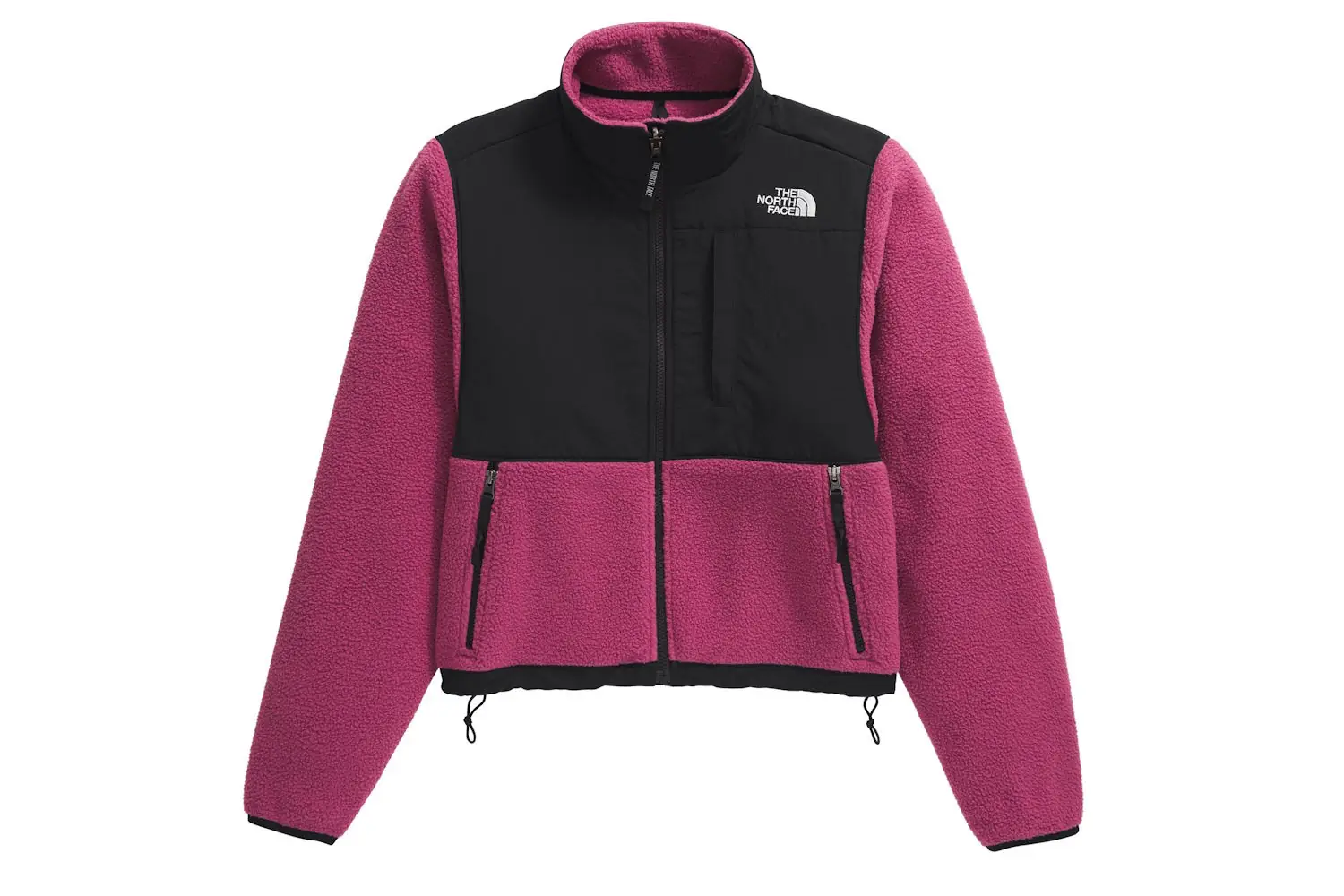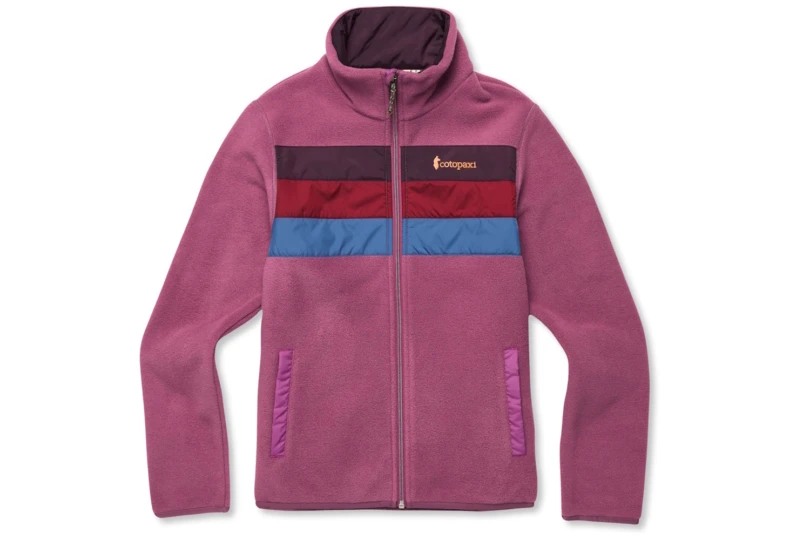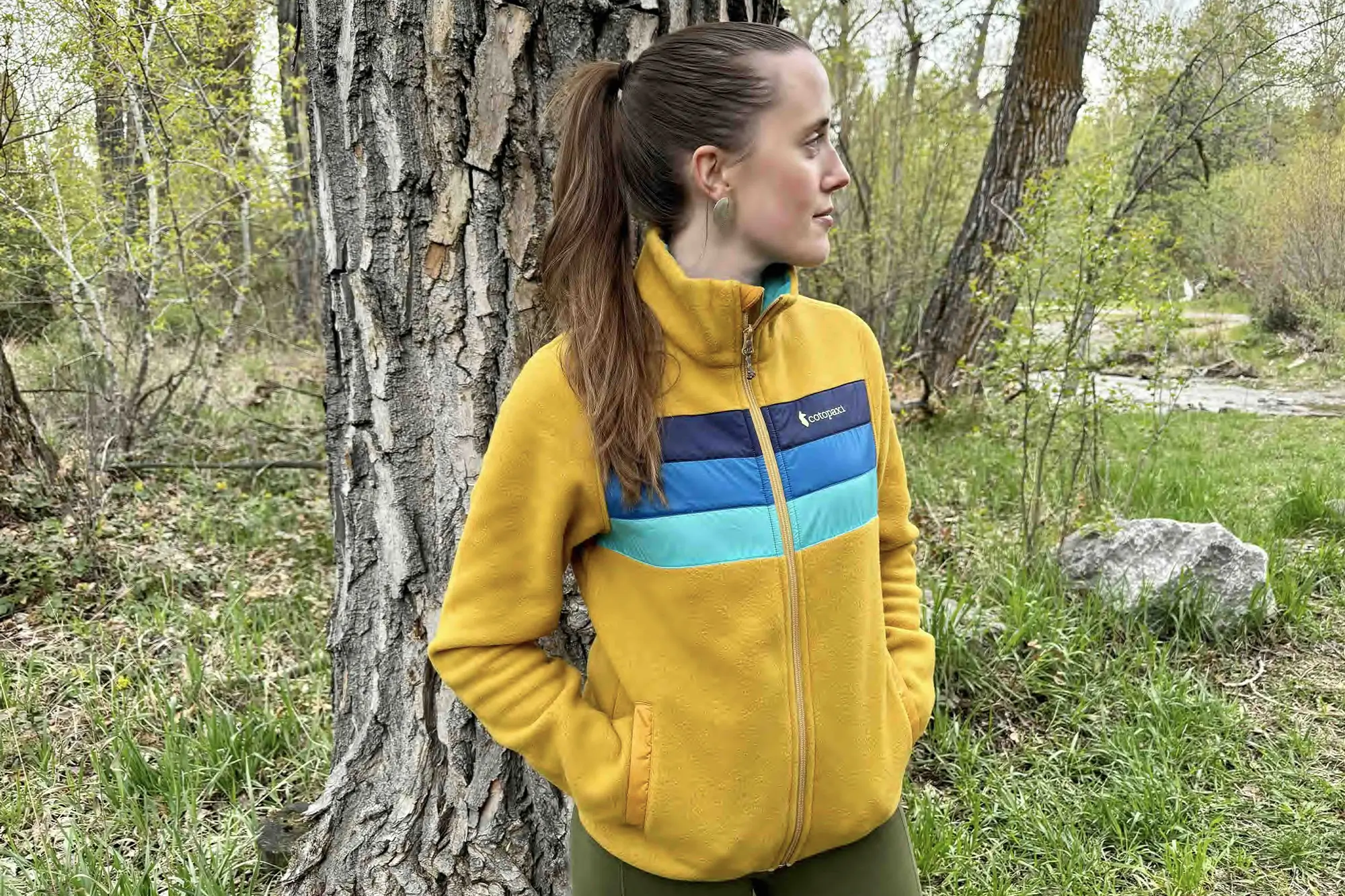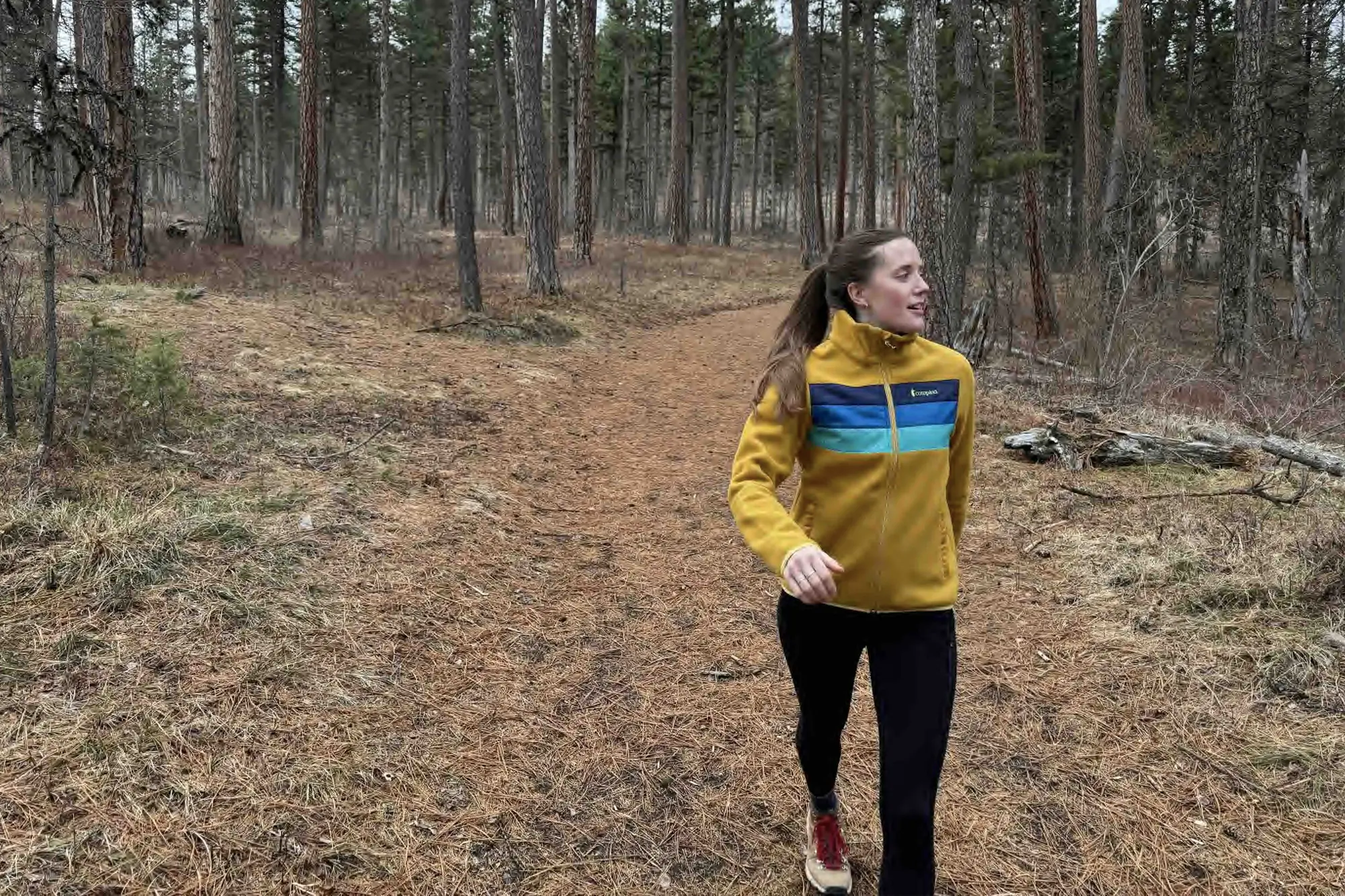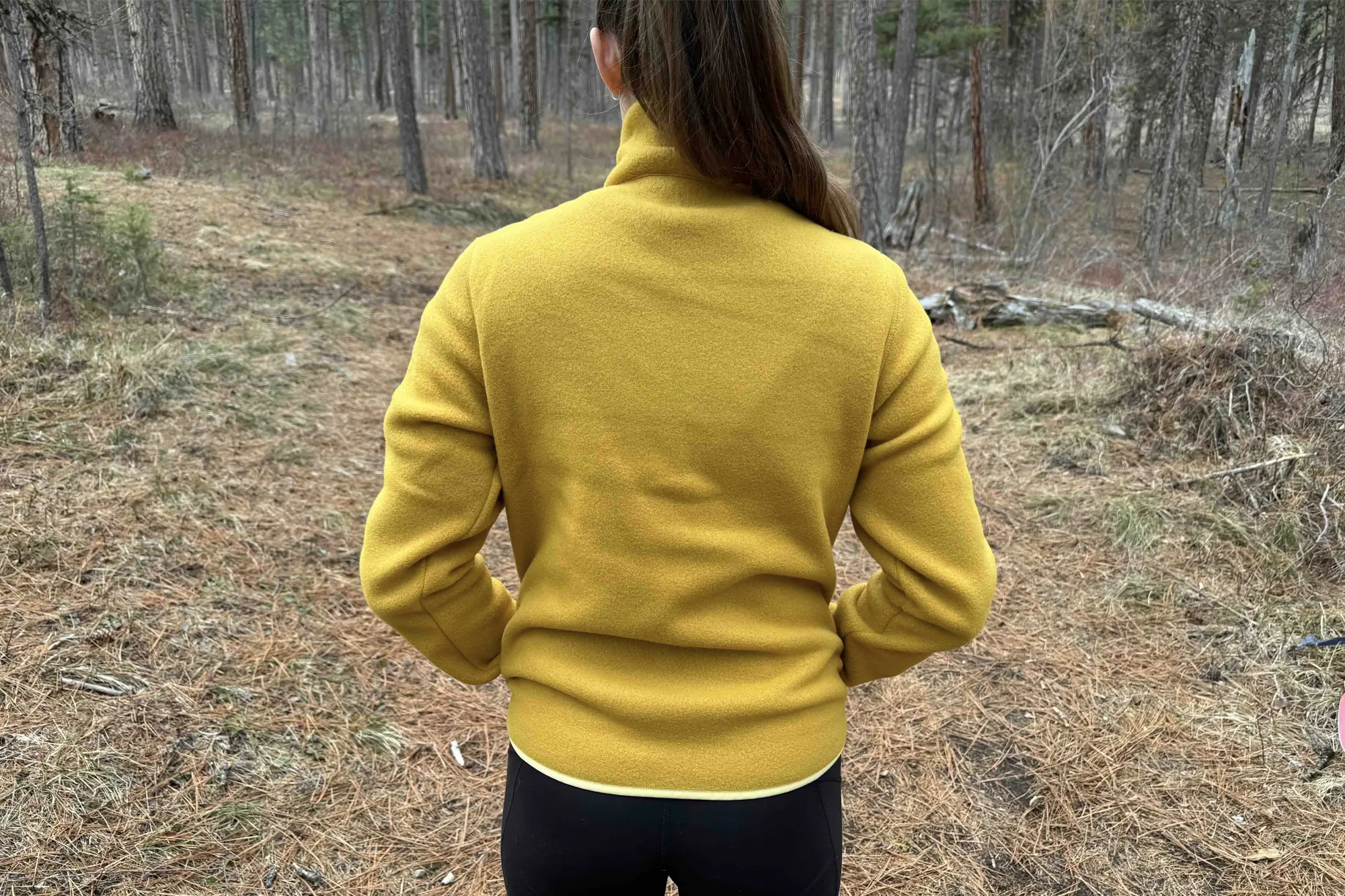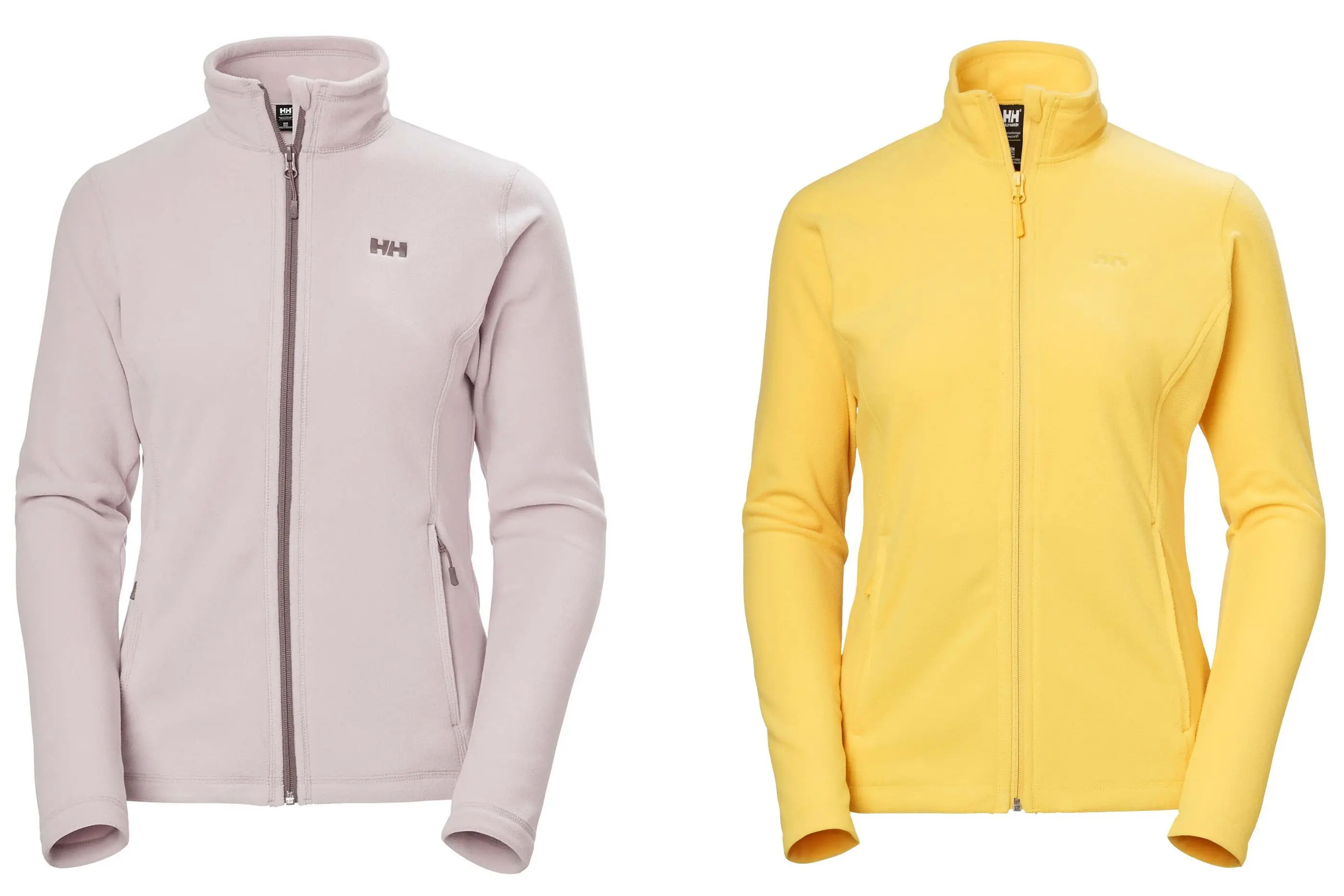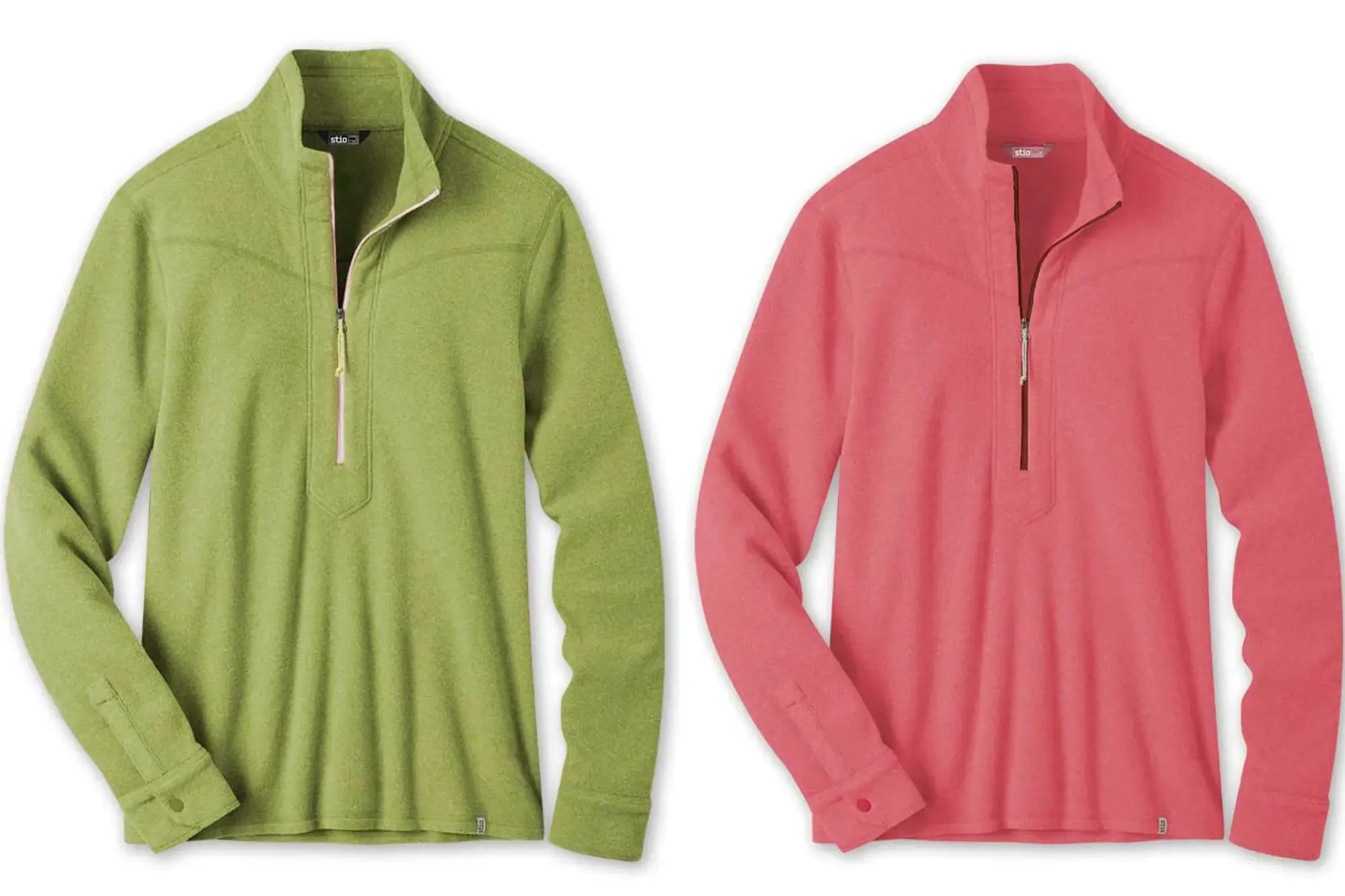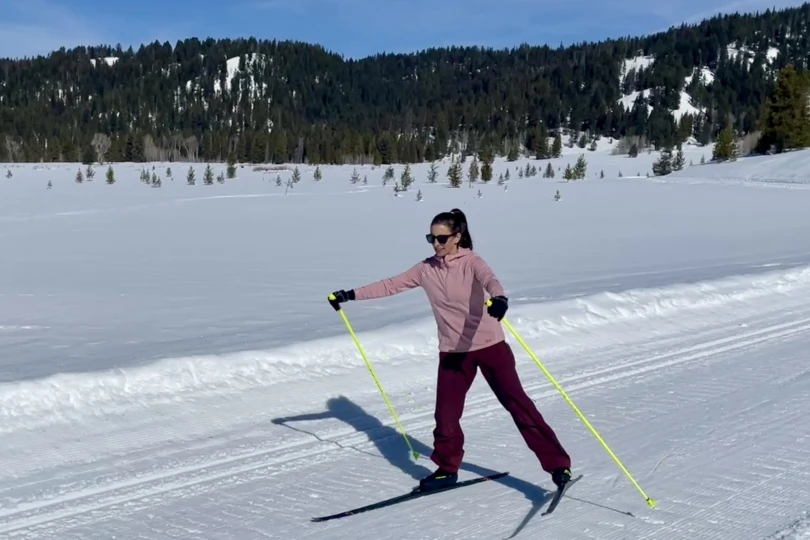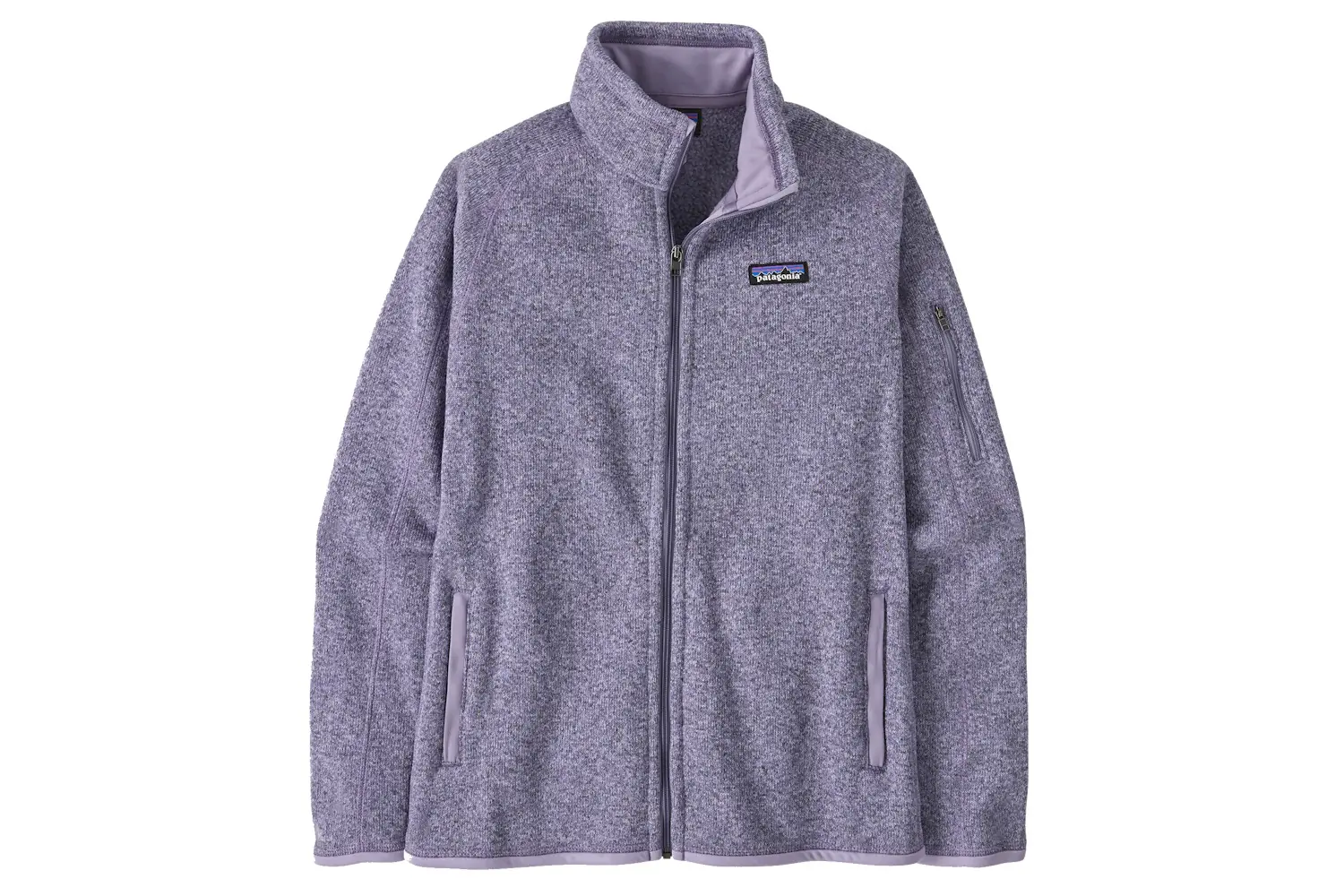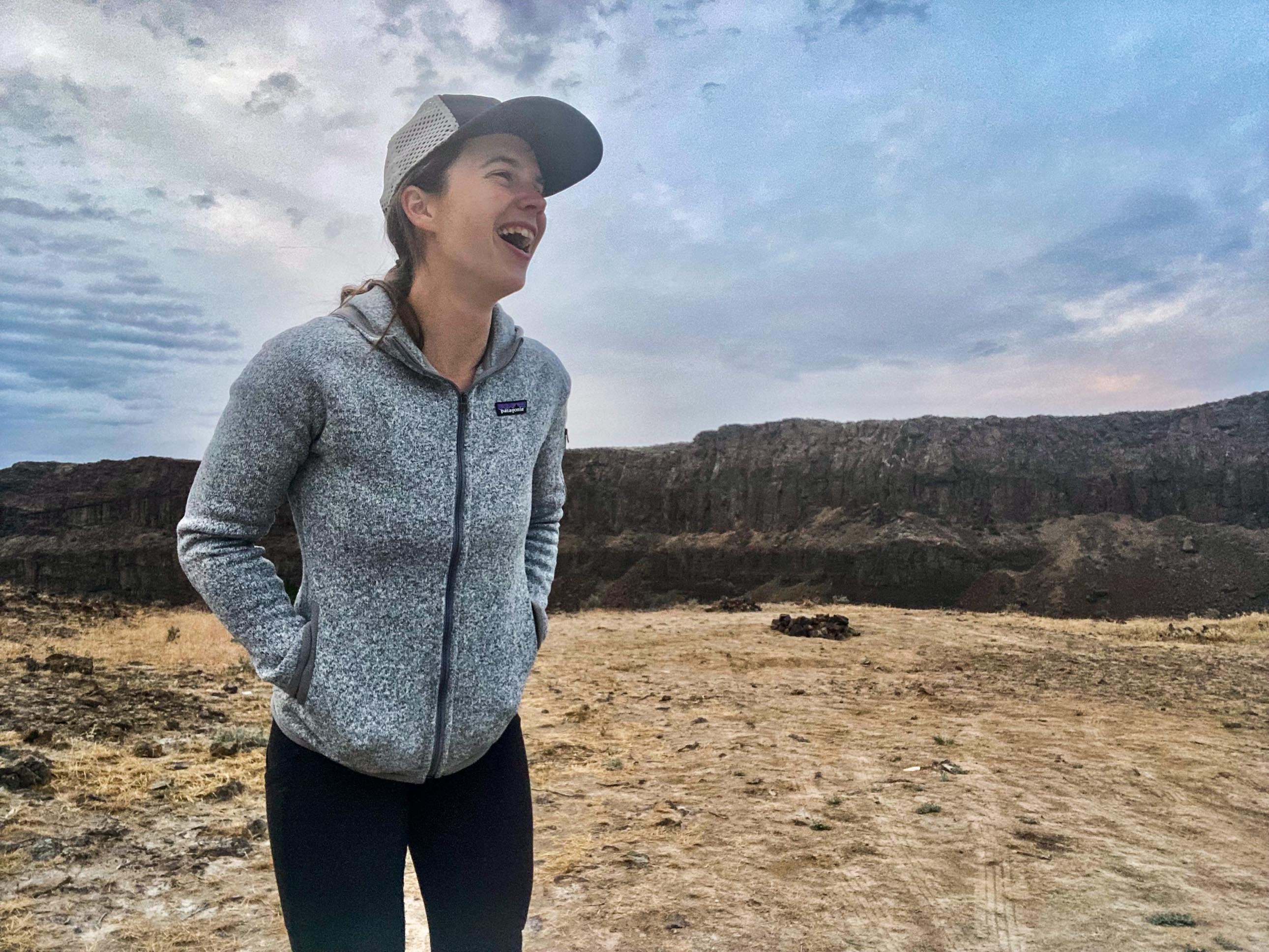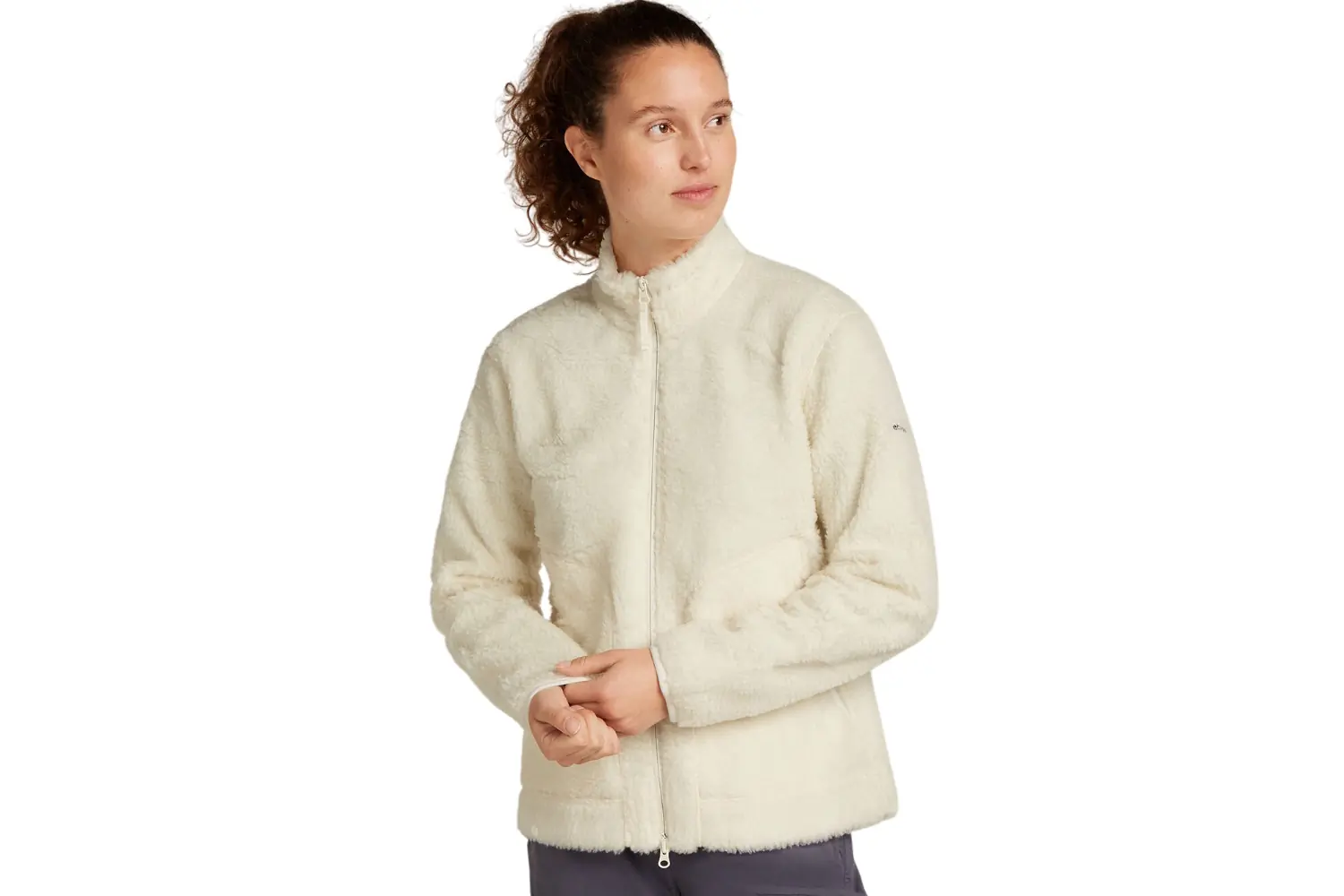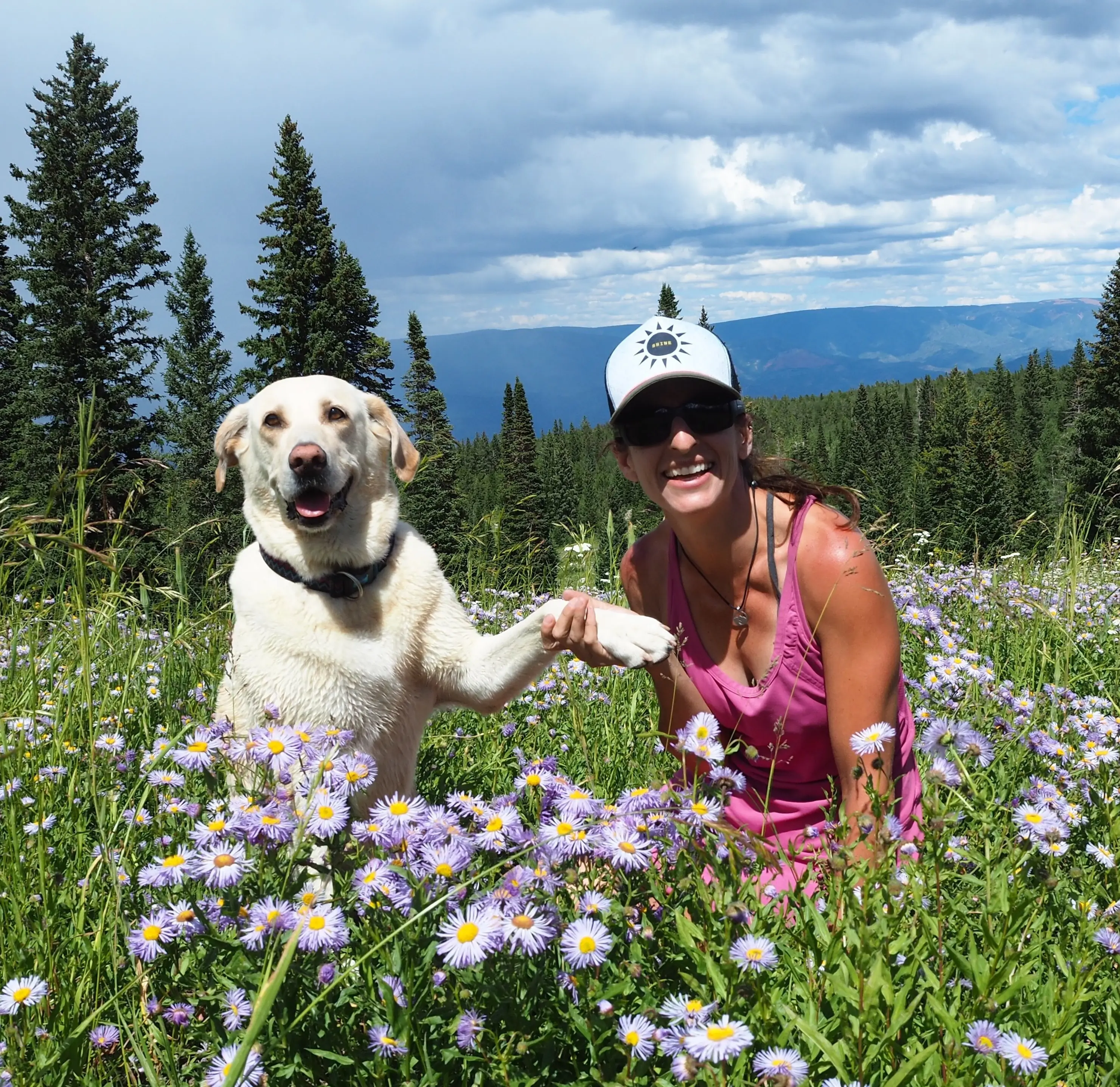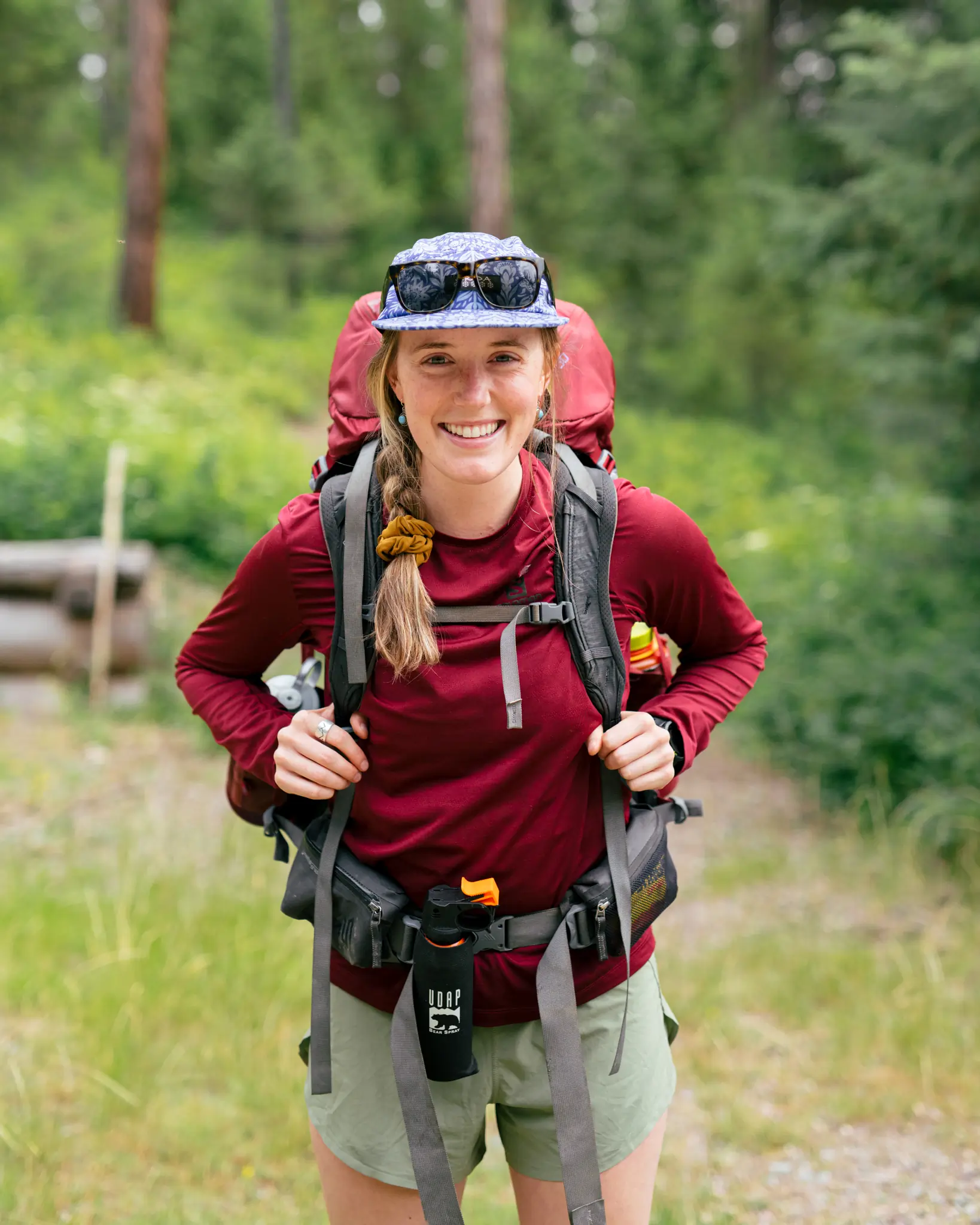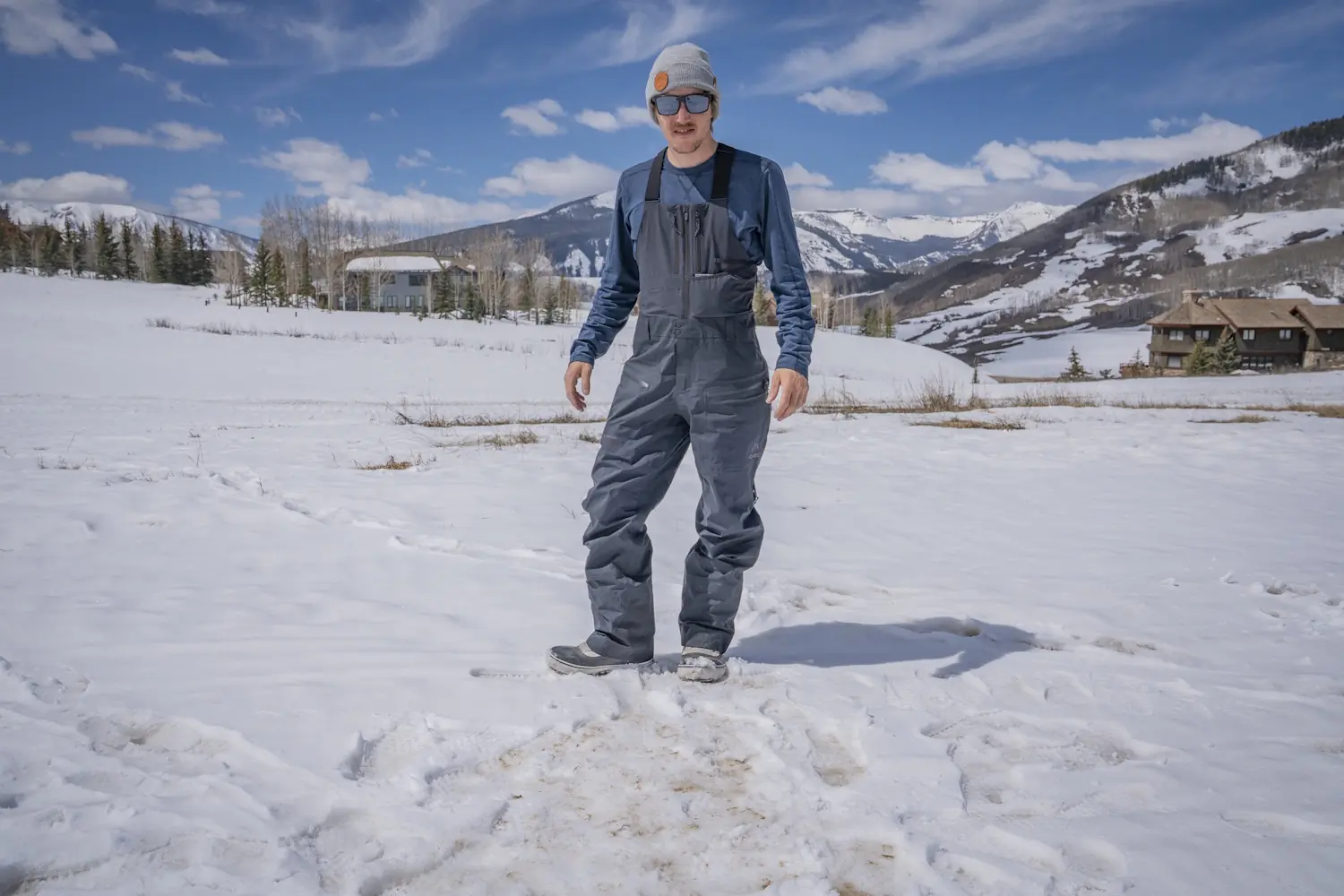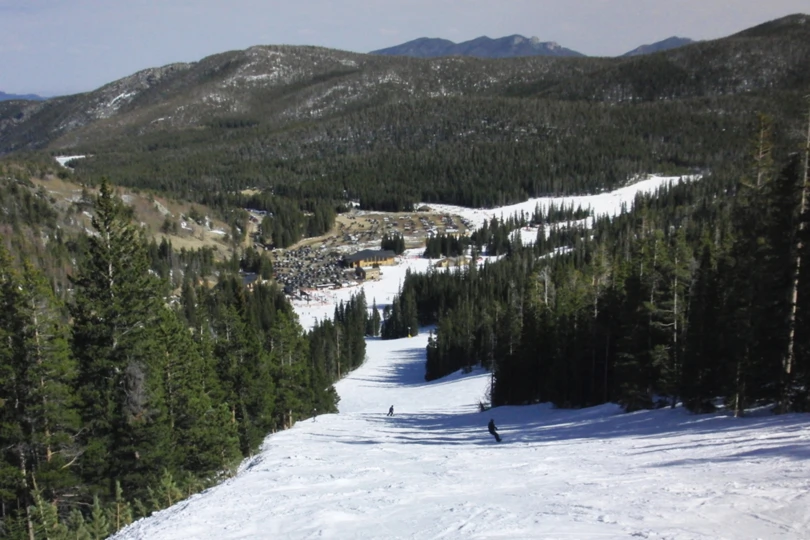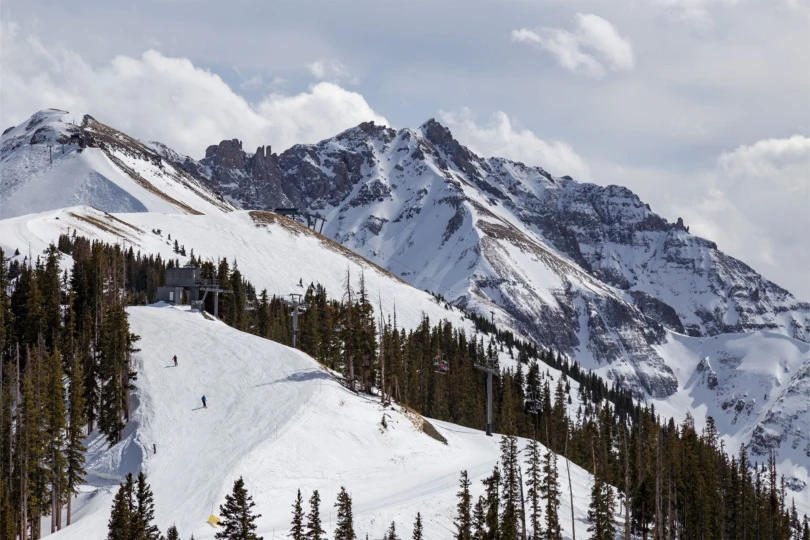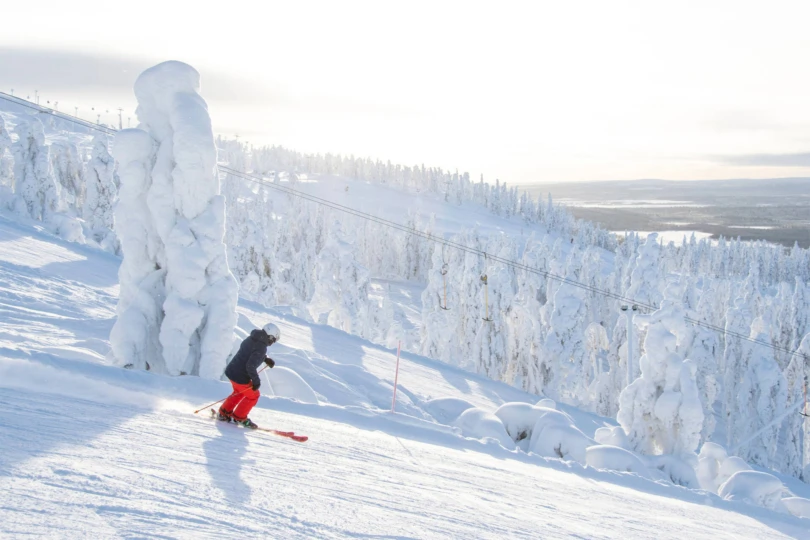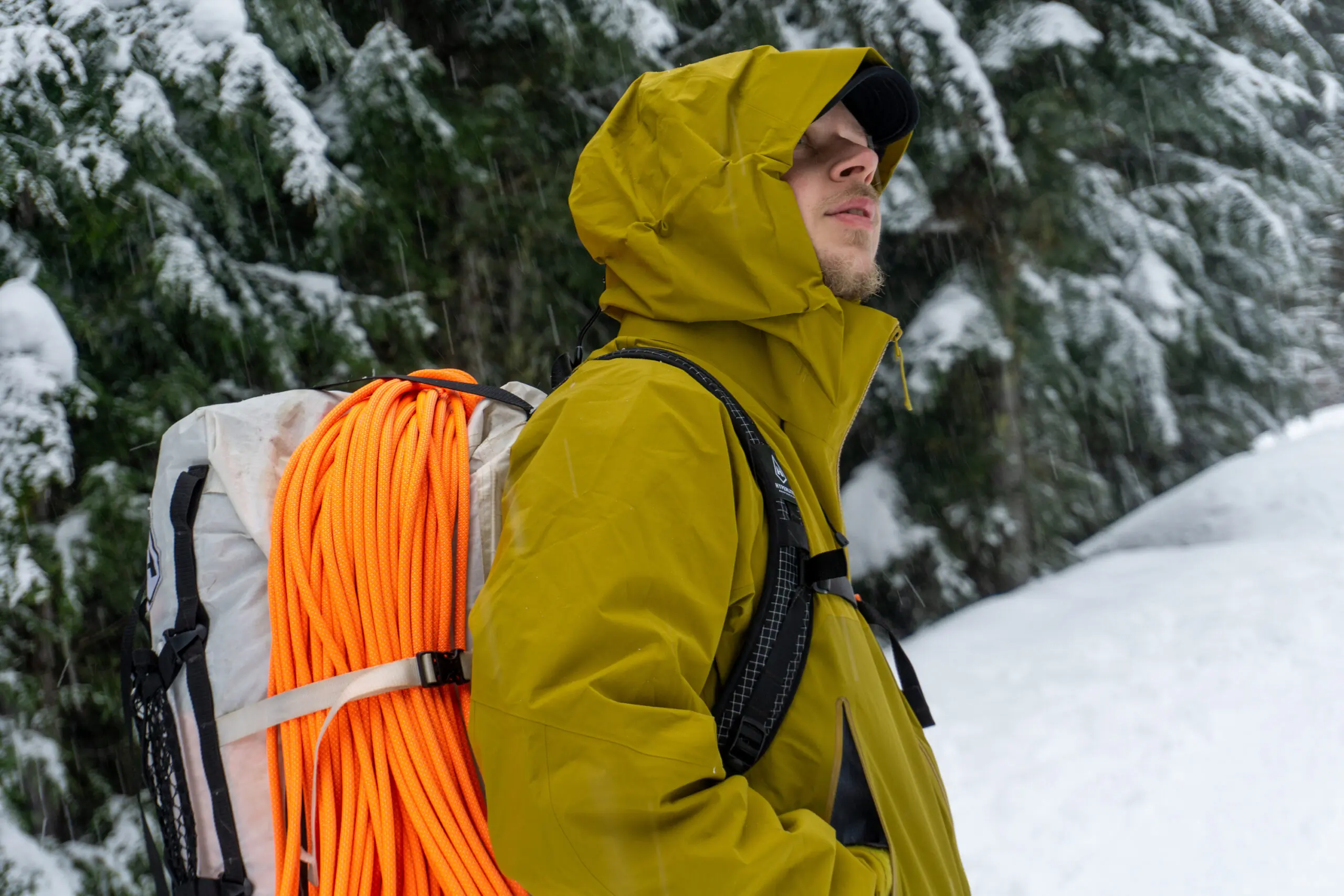From cozy campfire layers to dependable midlayers on the mountain, the best fleece jackets for women offer warmth, comfort, and everyday versatility. Beyond the exact fabric, pile, and aesthetic, fleece midlayers also deliver weatherproof protection and various levels of durability. Our testing team of lady crushers put dozens of jackets to the test in the Tetons, the Rockies, and the Sierra.
If you’re looking for a tenacious textile with water and wind resistance, consider the Arc’teryx Kyanite Hoodie. Look at the REI Co-Op Flash Hyperstretch Fleece Jacket for a budget pick that performs extremely well.
Editor’s Note: We updated this guide on October 31, 2025, to add three fleeces: the Outdoor Research Trail Mix XT Fleece Cowl Pullover, our favorite pullover style; the Outdoor Research Crescent Fleece Full Zip Hoodie, a cozy heavyweight layer; and the Arc’teryx Delta Jacket, our top lightweight technical pick. We also added detailed ratings to each product to offer better insight into our testing process.
The Best Fleece Jackets for Women in 2025-2026
Best Heavyweight Fleece Jacket for Women
Patagonia R1 Thermal Full-Zip Hoody – Women’s
8.7/10 RatingBest Pullover Fleece Jacket for Women
Outdoor Research Trail Mix XT Fleece Cowl Pullover
8.4/10 RatingArc’teryx Kyanite Hoodie – Women’s
-
Breathability
8.5
-
Durability
8.5
-
Wind & Water Resistance
8.0
-
Packability
8.0
- Weight: 12.1 oz.
- Fit: Athletic
- Fabric: Polartec Powerstretch Pro: 53% recycled polyester, 38% nylon, 9% elastane
- Density: Midweight
- Special features: Helmet-compatible hood
Pros
- Wind-resistant fabric
- Stretchy
- Attractive cut that’s easy to layer
Cons
- No thumb loops
- Fabric retains body odor
- Hood might be a no-go for some
REI Co-Op Flash Hyperstretch Fleece Jacket
-
Breathability
7.8
-
Durability
7.5
-
Wind & Water Resistance
6.0
-
Packability
6.0
- Weight: 11 oz.
- Fit: Athletic
- Fabric: 54% recycled polyester, 35% nylon, 11% spandex
- Density: Light to Midweight
- Special features: Zippered hand pockets, drawcord hem
Pros
- Stretchy
- Slightly longer length with drawcord hem
- Affordable
- Hood stays on while running
Cons
- No thumbholes
Patagonia R1 Air Full-Zip Hoody – Women’s
-
Breathability
9.5
-
Durability
8.0
-
Wind & Water Resistance
6.0
-
Packability
8.0
- Weight: 10.9 oz.
- Fit: Athletic
- Fabric: 100% recycled polyester
- Density: Lightweight
- Special features: Slim-fit hood and chest pocket
Pros
- Highly breathable
- Sleek fit makes layering easy
- Form-fitting hood doubles as a hat
- Great feel against skin
Cons
- Doesn't block the wind
Arc’teryx Delta Jacket – Women’s
-
Breathability
9.0
-
Durability
8.0
-
Wind & Water Resistance
7.0
-
Packability
8.5
- Weight: 6.9 oz.
- Fit: fitted
- Fabric: 100% polyester
- Density: Lightweight
- Special features: Two zippered hand pockets, 1 chest pocket, chin guard
Pros
- Breathable
- Excellent warmth-to-weight performance
- Trim technical fit with great mobility
- Streamlined design with minimal bulk
Cons
- Limited features, only one pocket
Patagonia R1 Thermal Full-Zip Hoody – Women’s
-
Breathability
5.5
-
Durability
8.5
-
Wind & Water Resistance
9.0
-
Packability
6.0
- Weight: 12.5 oz.
- Fit: Slim
- Fabric: 91% recycled polyester/9% spandex flat-faced Technostretch fleece
- Density: Midweight
- Special features: 2 zippered chest pockets, weather-resistant panels
Pros
- Extremely warm
- Smooth face fabric blocks wind and shed snow
- Plush and comfortable
- Super stretchy/moves with you
Cons
- No hand pockets
- Not the most breathable
Outdoor Research Trail Mix XT Fleece Cowl Pullover
-
Breathability
7.0
-
Durability
8.5
-
Wind & Water Resistance
6.5
-
Packability
7.0
- Weight: 11.1 oz.
- Fit: Standard
- Fabric: 100% recycled polyester
- Density: Midweight
- Special features: Stylish, cowl neck, kangaroo pocket w/internal mesh pocket
Pros
- Extremely warm
- Unique cowl neck adds coverage without bulk
- Stretchy, comfortable fit with thumbholes
- Versatile for trail or everyday wear
- Extremely stylish
Cons
- Not wind- or water-resistant
- Semi-breathable
Other Women’s Fleece Jackets To Keep You Cozy
-
Breathability
9.0
-
Durability
7.0
-
Wind & Water Resistance
6.0
-
Packability
8.0
- Weight: 7.8 oz.
- Fit: Athletic
- Fabric: 100% recycled polyester
- Density: 140g/m2, 127 g/m2 (Lightweight)
- Special features: UPF 30-50+ hybrid fabric protection
Pros
- Breathable
- Anti-stink fabric
- Long Anorak-style zipper for regulating heat
Cons
- Tight thumb loops
-
Warmth
7.0
-
Durability
8.0
-
Style
7.0
-
Breathability
5.5
- Weight: 14.5 oz.
- Fit: Standard
- Fabric: 70% Recycled Polyester, 29% Merino Wool, 1% Spandex
- Density: Midweight
- Special features: UPF 50+, zippered hand pockets, stretch hood, interior pocket
Pros
- Thick, warm sweater-knit fleece
- Full-zip and hood add versatility
- Durable feel and clean style for casual wear
- Multiple pockets for storage
Cons
- Limited breathability for high-output activities
- Bulky and not very packable
-
Breathability
4.5
-
Durability
8.0
-
Wind & Water Resistance
8.0
-
Packability
4.5
- Weight: Unavailable
- Fit: Relaxed
- Fabric: 100% recycled polyester
- Density: Heavyweight
- Special features: Stylish, pit zips, weather-resistant panels
Pros
- Stylish
- Very warm
- Fairly weather-resistant
- Has a number of cool features for a non-technical fleece
Cons
- Heavy & bulky
- Slightly cropped
- Not breathable
-
Breathability
4.5
-
Durability
9.0
-
Wind & Water Resistance
8.0
-
Packability
3.0
- Weight: 12.9 oz. (small)
- Fit: Athletic
- Fabric: 100% recycled polyester fleece, repurposed polyester taffeta with DWR finish
- Density: 255 gsm
- Special features: Recycled materials
Pros
- Distinctive style
- Recycled materials
- Warm but still packable
Cons
- Tight across the chest
- No zip pockets
- No hood
-
Breathability
8.0
-
Durability
9.0
-
Wind & Water Resistance
8.0
-
Packability
7.5
- Weight: 14.8 oz.
- Fit: Slim
- Fabric: 90% polyester, 10% spandex
- Density: Midweight
- Special features: Durable exterior face fabric
Pros
- Lots of pockets
- Tenacious face fabric
Cons
- On the expensive side
- Fit might be long on shorter torsos
-
Breathability
6.0
-
Durability
7.0
-
Wind & Water Resistance
3.0
-
Packability
6.0
- Weight: 8.5 oz.
- Fit: Athletic
- Fabric: 100% recycled Polartec polyester
- Density: 100 gsm (Lightweight)
- Special features: 100% recycled polyester
Pros
- Eco-friendly design
- Lightweight
- Clean aesthetic
- Plus sizes up to 3X — a rare find
Cons
- Doesn’t shield wind, rain, or snow
- Not the easiest to layer over a long-sleeve base layer
-
Breathability
8.5
-
Durability
5.0
-
Wind & Water Resistance
5.0
-
Packability
8.5
- Weight: 7.8 oz.
- Fit: Regular
- Fabric: Recycled heather microfleece, 65% REPREVE recycled polyester, 35% polyester
- Density: Midweight
- Special features: Half-zip for temperature regulation, shirt-style cuffs and yokes
Pros
- Recycled materials
- Snap cuffs, curve front add style and a touch of Western flair
- Thick and soft feel
- Microfleece wicks moisture, dries quickly
Cons
- No hood (also pro, depending on your preferences!)
- Not wind resistant
-
Breathability
6.5
-
Durability
8.5
-
Wind & Water Resistance
7.0
-
Packability
5.0
- Weight: 16.9 oz
- Fit: Athletic
- Fabric: 100% recycled polyester
- Density: Midweight
- Special features: Slim-fit hood and chest pocket
Pros
- Low maintenance
- Comfortable and stylish
- Plenty of zip pockets
Cons
- Not very breathable
- Too heavy and bulky for backpacking
-
Breathability
5.0
-
Durability
6.5
-
Wind & Water Resistance
7.0
-
Packability
4.0
- Weight: 26.5 oz.
- Fit: Athletic
- Fabric: 100% merino wool with 60% Lyocell, 40% merino wool liner
- Density: Lightweight
- Special features: Smooth lining, zippered hand pockets
Pros
- Zippered hand pockets
- Very warm
- High neck
Cons
- Expensive
- Poor quality zipper
-
Breathability
6.0
-
Durability
7.5
-
Wind & Water Resistance
5.5
-
Packability
6.5
- Weight: 14.1 oz.
- Fit: Relaxed
- Fabric: Polyester
- Density: Midweight
- Special features: Zippered chest pocket
Pros
- Modern, sporty design
- Affordable price
- Warm and comfortable
Cons
- Some reviewers found the fabric a tad rough
- The zipper sometimes snagged, according to users
Women’s Fleece Jacket Comparison Chart
Scroll right to view all of the columns: Price, Weight, Fit, Fabric, Density.
| Fleece Jacket | Price | Weight | Fit | Fabric | Density |
| Arc’teryx Kyanite Hoodie | $200 | 12.1 oz. | Athletic | Polartec Powerstretch Pro: 53% polyester, 38% nylon, 9% elastane | Midweight |
| REI Co-Op Flash Hyperstretch Fleece Jacket | $100 | 11 oz. | Athletic | 54% recycled polyester, 35% nylon, 11% spandex | Light to Midweight |
| Patagonia R1 Air Full-Zip Hoody | $189 | 10.9 oz. | Athletic | 100% recycled polyester | Lightweight |
| Arc’teryx Delta Jacket | $200 | 6.9 oz. | fitter | 100% polyester | Lightweight |
| Patagonia R1 Thermal Full-Zip Hoody | $219 | 12.5 oz. | Slim | 91% recycled polyester/9% spandex flat-faced Technostretch fleece | Heavyweight |
| Outdoor Research Trail Mix XT Fleece Cowl Pullover | $100 | 11.1 oz. | Standard | 100% recycled polyester | Midweight |
| Norrøna senja warm1 Hood | $189 | 7.8 oz. | Athletic | 100% recycled polyester | Lightweight |
| Outdoor Research Crescent Fleece Full Zip Hoodie | $200 | 14.5 oz. | Standard | 70% Recycled Polyester, 29% Merino Wool, 1% Spandex | Midweight |
| The North Face Retro Denali Jacket | $180 | N/A | Relaxed | 100% recycled polyester | Heavyweight |
| Cotopaxi Teca Fleece Full-Zip Jacket | $120 | 12.9 oz. (small) | Athletic | 100% recycled polyester fleece, repurposed polyester taffeta with DWR finish | Heavyweight |
| Patagonia R2 CrossStrata | $199 | 14.8 oz. | Slim | 90% polyester, 10% spandex | Midweight |
| Helly Hansen Daybreaker Fleece Jacket | $80 | 8.5 oz. | Athletic | 100% recycled Polartec polyester | Lightweight |
| Stio Turpin Fleece Half Zip | $89 | 7.8 oz. | Regular | Recycled Heather Microfleece, 65% REPREVE® Recycled Polyester, 35% Polyester | Midweight |
| Patagonia Better Sweater Jacket | $159 | 16.9 oz. | Athletic | 100% recycled polyester | Midweight |
| Icebreaker RealFleece Merino High Pile Long Sleeve Zip Jacket | $400 | 26.5 oz. | Athletic | 100% merino wool with 60% Lyocell, 40% merino wool liner | Lightweight |
| Kari Traa Rothe Midlayer Fleece Jacket | $110 | N/A | Relaxed | 100 % polyester | Midweight |

How We Tested Women’s Fleece Jackets
We tested every fleece jacket for women in a wide range of conditions and activities, putting them through the wringer across environments, seasons, and weather conditions. From shoveling snow to jogging and running errands, we used them for activities you will encounter in daily life.
Our Expert Testers
Lead tester Kylie Mohr has lived in a four-season mountain climate for nearly 3 decades. Mohr tested these fleeces for their warmth, durability, and packability, throwing them on for alpine skiing, ski touring, trail running, shoulder season hiking and mountain biking, and simply just walking the dog on chilly mornings.
Over the last year, she spent over 75 hours wearing the five new fleeces she tested for this guide, seeing how they compared with each other and other favorites in her closet. Fleeces journeyed with her to multiple national parks and even Japan.
Senior Editor Morgan Tilton grew up in the Colorado Rockies and lives in the Gunnison Valley, one of the coldest places in the U.S. She pulls on a fleece year-round, from camping to yard work and downhill skiing or snowboarding. Fleece midlayers have rotated through her closet for her entire life. A range of skilled outdoor experts worked with Tilton throughout the guide’s seven iterations since 2021. That list includes an AMGA-certified rock guide, sugar beet harvester, ski patrol trail guide, and a professional wildlife photographer-rancher. In 2025, GearJunkie editor Chris Kassar, who lives in Jackson, Wyoming, took over the guide, adding a few of her favorites and expanding some reviews based on further testing.
Our Testing Grounds
These fleece jackets accompanied us while alpine skiing and on backcountry tours in Idaho, Wyoming, Montana, and Colorado. They proved their durability and heat retention while rowing Idaho’s wildest whitewater working the land in North Dakota farmlands, and ascending cracks in Utah’s Indian Creek. We used these pieces rock climbing Colorado’s high-elevation peaks and limestone walls.
Temperatures stretched from splitting cold at sunrise to scorching beneath the sun during fieldwork. These layers protected us while glassing for animals and trail running. Other designs helped keep us warm while we cleaned farm machinery, pedaled cruisers around town, and cooked meals at the campsite.
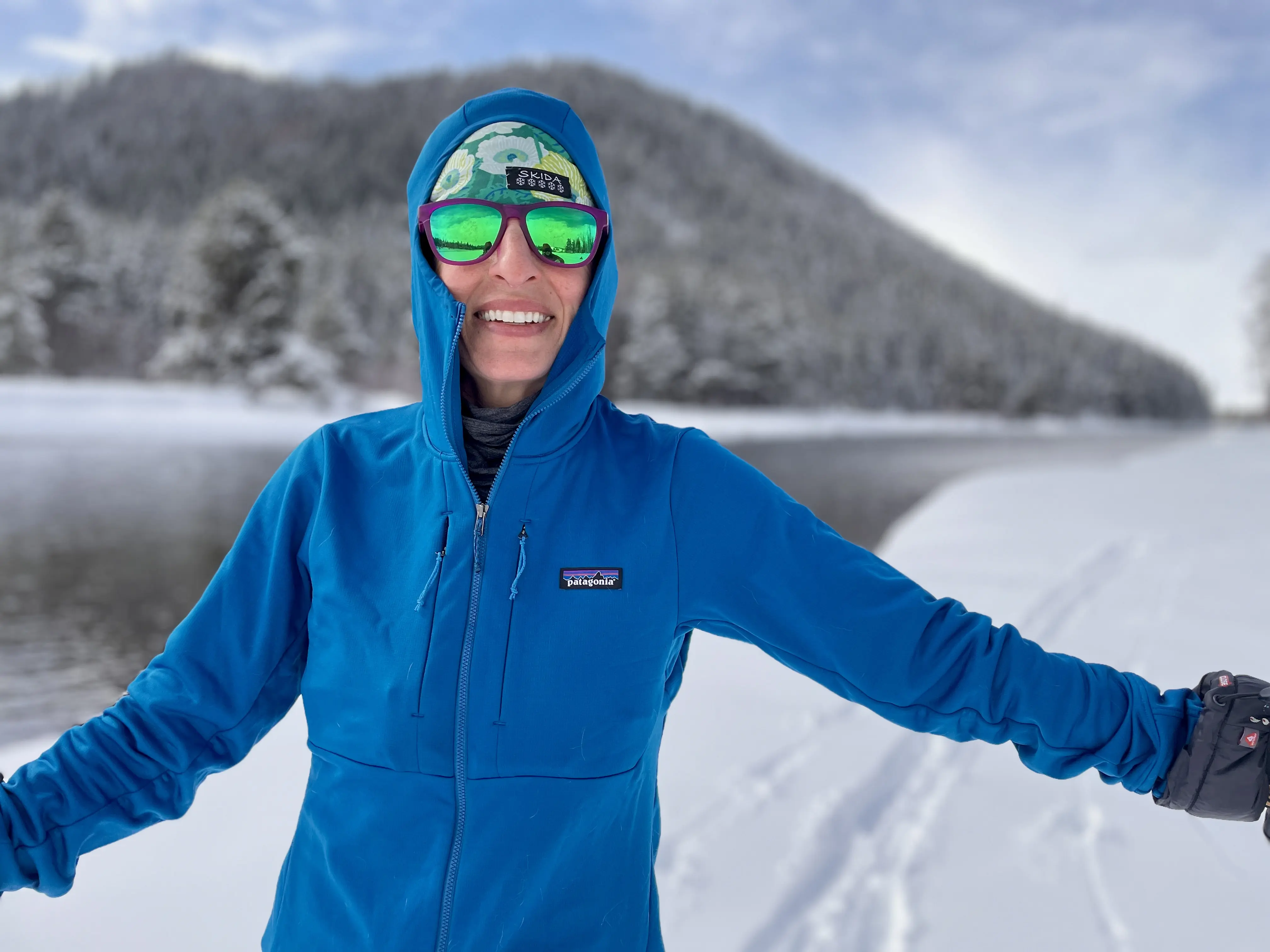
Our Testing Process
Using first-hand experience and research, we narrowed down this season’s best fleece for women who work and play outside regularly. While field testing our fleece, we consider overall fit, warmth, density, weight, quality, durability, comfort, stretch, odor resistance, breathability, and value. We also take a close look at the features, including the zippers, zip pulls, hems, hood, seams, and pockets.
Before narrowing the selection, we take into account the most innovative, sustainable, novel, objective-specific, popular, highly rated, and legacy products across a range of price points. We’re confident this list includes the best women’s fleece jackets on the market that serve a variety of budgets and end uses.
Our Rating System for Women’s Fleece Jackets
For each women’s fleece jacket we tested, we scored it from 1 to 10 in four key performance areas: breathability, durability, wind and water resistance, and packability. Breathability reflects how effectively the fleece moves heat and moisture away from the body during activity. Durability measures how well it stands up to repeated use, pack abrasion, and washing, including pilling or snagging. Wind and water resistance shows how much protection the fabric and construction provide from gusts or light precipitation. Packability indicates how small and light the fleece compresses for stashing in a pack or travel bag.
The overall score is not a simple average of those numbers. Instead, it represents our testers’ editorial judgment of the full user experience —warmth, comfort, versatility, and performance in the field — after weeks of real-world use. A jacket that feels exceptional in daily wear or performs far better in wind may receive a higher overall score than its category scores alone might suggest.
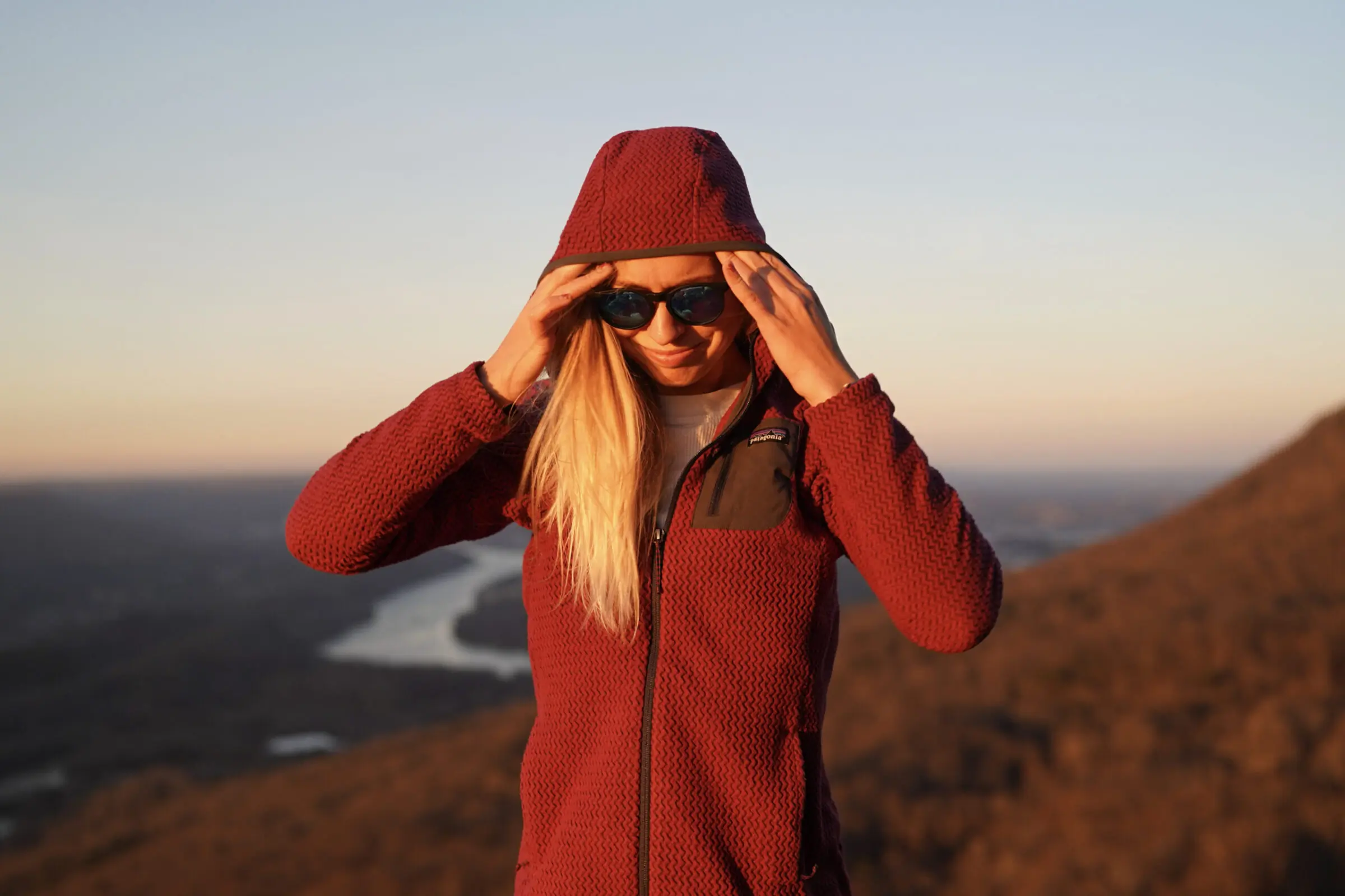



Buyer’s Guide: How to Choose the Best Fleece Jacket for Women
Fleece is a human-made fabric that is soft, fuzzy, and imitates wool fleece Most brands use it to make a variety of insulating midlayers and lightweight jackets or vests that often have a full or partial front zipper.
Synthetic materials like polyester or a polyester blend typically makeup fleece.
It’s not to be confused with wool fleece, which comes from a variety of animals including sheep, alpacas, and goats.
For this guide, we focused on fleece jackets rather than vests.
Fleece Jackets for Women: History
Modern fleece was born out of a collaboration between Patagonia and a company called Malden Mills Industries, now Polartec.
Maiden Mills developed the first-ever synthetic fleece textile in 1981. Patagonia wanted to mimic and tweak wool, which rock climbers and backpackers were wearing at the time, and make something lighter and quicker to dry.
Designers found synthetic pile at a fabric shop, then worked to soften initial stiff prototypes: made from material intended for toilet seat covers. An initial catalog description for the result, the “Patagonia Climbing Jacket,” called the jacket “very warm, wind and water-resistant” — qualities fleece jackets from all brands are loved today. In 1985, the iconic Synchilla Fleece pullover was born.
Benefits of Fleece
Fleece is generally breathable, wicks moisture, and is quick-drying. Those qualities can be good for cardio activities like backcountry skiing, trail running, backpacking, or hiking.
Designs vary based on their warmth-to-weight ratio, wind and water resistance, bulkiness, and features like thumbholes, pockets, or hoods.
Fleece vs. Wool
Wool, on the other hand, regulates temperature well, shields wind, and carries anti-odor properties. Wool is also naturally water-repellent due to the lanolin that coats the fibers. Comparatively, fleece wets quicker than wool but dries faster.


High-Pile Fleece
High-pile fleece is that plush, blanket-like fleece jacket. It looks cozy, cuddly, and sometimes, like a teddy bear. It’s also known as sherpa fleece because it has the feel and resemblance of a sheep’s coat. The prAna Polar Escape Snap Jacket is a super soft example of the sherpa look and feel, as is the Kari Traa Rothe Midlayer Fleece Jacket.
High-pile fleece can give off a throwback, retro vibe, since it’s reminiscent of early designs.
Warmth & Insulation
Fleeces offer varying levels of warmth and insulation from the cold, based on the type of fabric, weight, and any fabric liners. We classify all of our picks as midlayers, though some are warmer and more weather-resistant than others. In some conditions, these fleece work perfectly fine as an outer layer.
Lightweight
The lightest fleece jackets are around 100 gsm. These layers are great for high-aerobic activities like nordic skiing or running. They are generally more breathable and less bulky. An example of the best fleeces in this category is the Patagonia R1 Air Full-Zip Hoody and the Norrøna senja warm1 Hood.


Midweight
Moderate-weight midlayers are a bit thicker at 200 gsm but still could be used while active at colder temperatures. They offer good insulation and can be integrated into a complete layering system underneath a protective wind or rain shell. The REI Co-Op’s Flash Hyperstretch Fleece Jacket or the Cotopaxi Teca Fleece FullZip Jacket are good examples of a midweight option.
Heavyweight
The thickest fleece layers are around 300-400 gsm and are great for layering up at the campsite. They tend to be a bit bulkier and warmer than light or midweight fleeces. They typically aren’t as comfortable or breathable during high-output activities. The Patagonia R1 Thermal Full-Zip Hoody, prAna Polar Escape Snap Jacket and Icebreaker RealFleece Merino High Pile Long Sleeve Zip Jacket were among the heaviest-weight fleeces we tested.
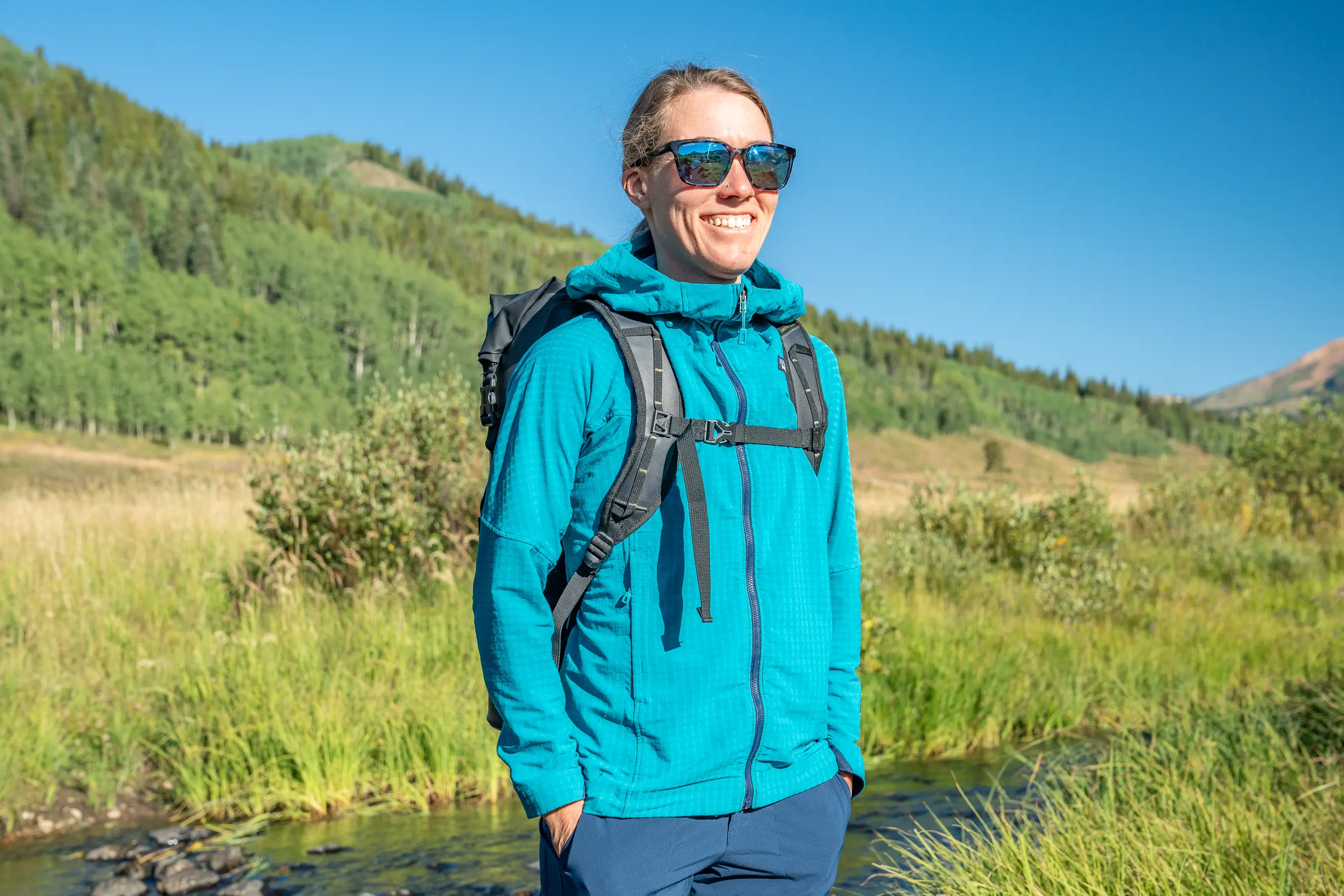



Layering Systems
Some of our favorite fleece jackets for women can be used as a standalone layer in adverse weather, though many are designed to be integrated with other jackets as part of a layering system. Using several layers allows you to stay comfortable as the conditions change or as your level of activity increases or decreases.
For example, if you are hiking uphill and start to sweat, you can shed your insulating layer (maybe it’s a fleece) and keep hiking in a base layer. Read more about base layers in our best baselayers for women guide. If the wind starts to howl, zip a wind shell or ski jacket over your fleece to trap heat. Learn more about outermost layering in our best ski jackets guide.
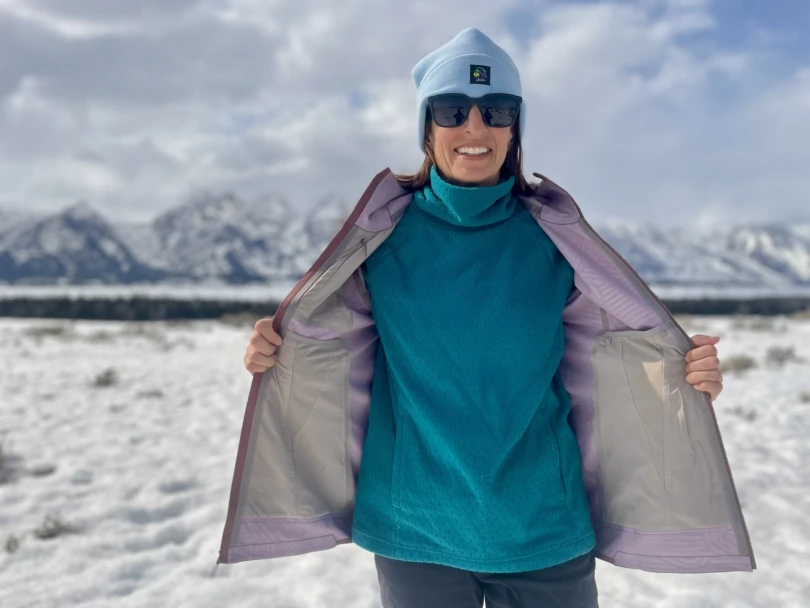



Wind & Water Resistance
Modern fleece designs often feature water-repellent treatments on the surface to prevent your fleece from absorbing moisture if weather conditions deteriorate. This means they do a much better job keeping you warm when it’s wet outside than, say, a cotton sweatshirt.
Some technical fabric with a DWR coat can do well with wind and water resistance like the Patagonia R2 CrossStrata. Most fleeces are not truly waterproof, however, and it’s still a good idea to bring a rain jacket as part of a complete layering system.
Some fleece jackets also have a fabric weave or outer coating that offers protection from the wind, like the Arc’teryx Kyanite Hoodie. These features are most useful when you intend to use your fleece as a standalone outer layer, as compared to an insulating midlayer.
Similarly, abrasion-repellent treatments on the outside of your fleece can enhance durability. This is especially useful for climbing, moving around equipment like a snowmobile, lifting objects, or other activities during which your jacket may be scraping against rough surfaces.
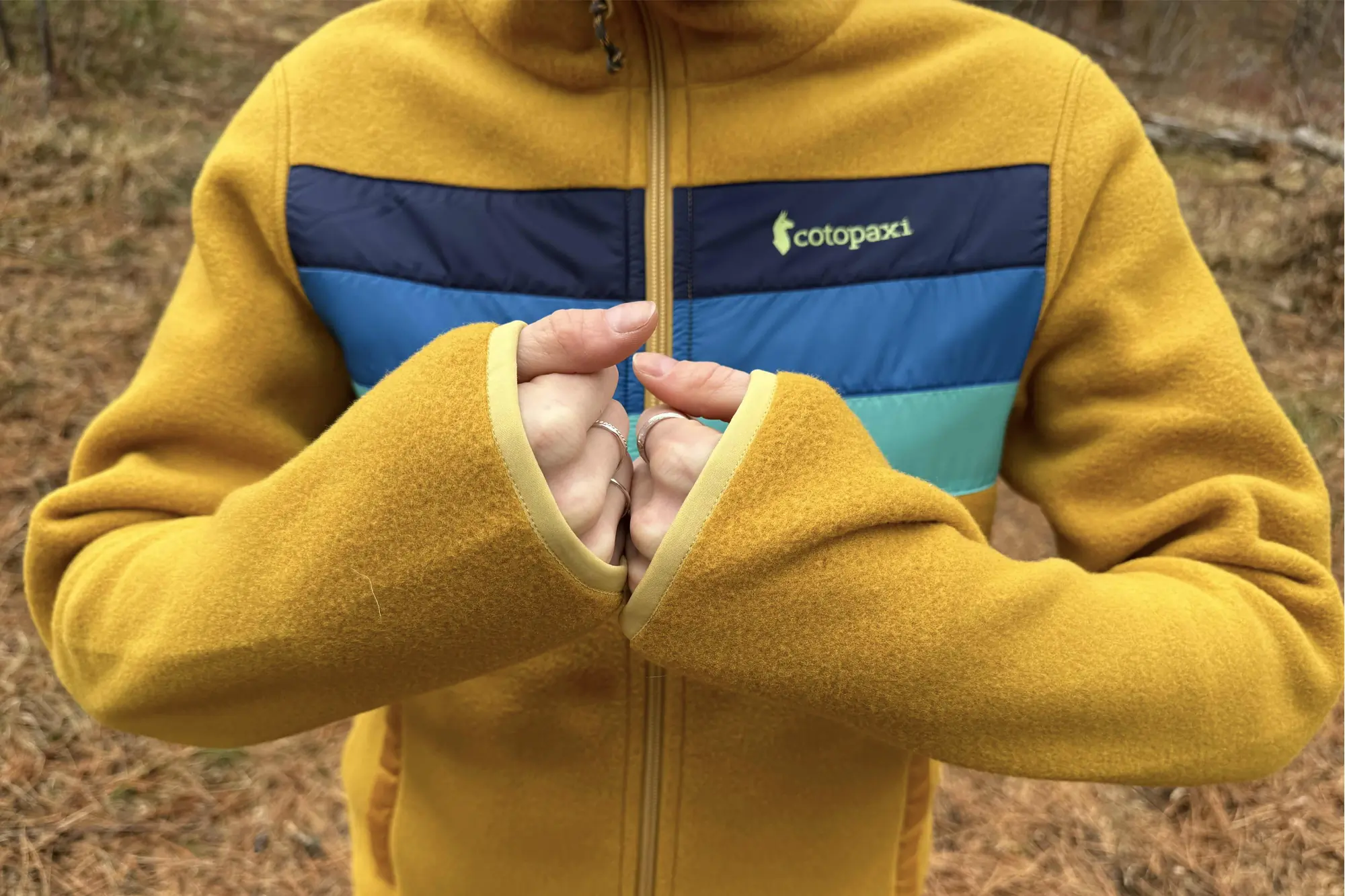



Materials
Polyester
Polyester, a synthetic fabric that’s derived from petroleum, is the classic fleece material used in light, medium and heavyweight jackets. Most of the fleece jackets in this guide are made from polyester; many brands use some or all recycled polyester from those pesky plastic water bottles, like the Cotopaxi Teca Fleece Full-Zip Jacket, the Patagonia Better Sweater Hoody, or the Helly Hansen Daybreaker Fleece Jacket. Virgin polyester requires more energy and water to make than recycled polyester, but both still shed microplastics.
Stretchier options, like the Arc’teryx Kyanite Hoodie or the REI Co-Op Flash Hyperstretch Fleece Jacket, add a small percentage of spandex or elastane to give their polyester some give.
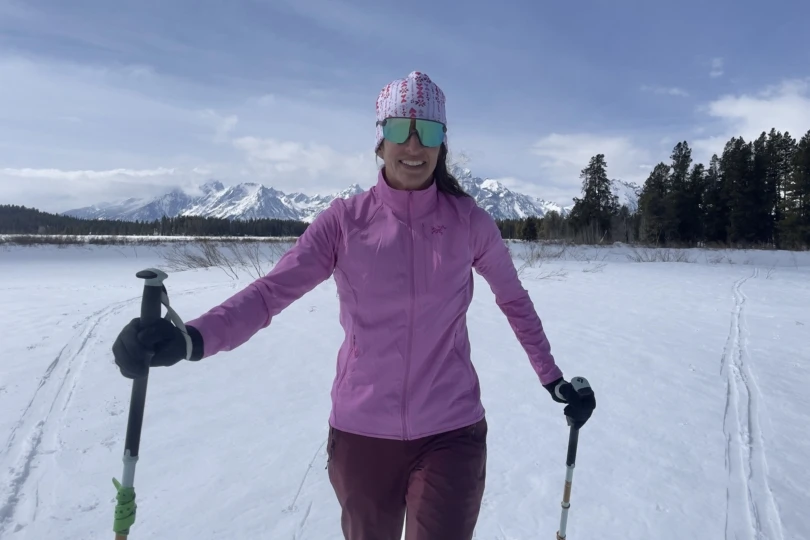



Cotton
Cotton has steep pros and cons. It’s more breathable than synthetic fabrics — yay! — but also extremely absorbent. Cotton can hold over 25 times its own weight in water. Doing high-output, sweaty activities in cotton can be uncomfortable and even dangerous, keeping you cold and wet.
Cotton is mostly used in fleeces as a lining to make high-pile fleece jackets comfortable on the skin, like the inner lining of the prAna Polar Escape Snap Jacket. Cotton is a fine material for lifestyle and casual pieces, but we wouldn’t recommend taking cotton materials into the backcountry.
Wool
Wool regulates temperature well, shields wind, and carries anti-odor properties. It is also naturally water-repellent due to the lanolin that coats the fibers. Comparatively, fleece wets quicker than wool but dries faster.
The downside of wool? It tends to be heavier, so keep that in mind when considering a wool versus polyester fleece for long treks where every ounce matters. Other considerations for wool include the treatment of the sheep it comes from. Many companies will share where their wool comes from and what practices they follow.
The only jacket in this guide made with 100% Merino wool is the Icebreaker RealFleece Merino High Pile Long Sleeve Zip Jacket, which is lined with a combination of 60% Lyocell and 40% Merino wool. The Norrøna Trollveggen Powerstretch Pro Zip Hood has a polyester and wool blend on the side panels.
Wood Pulp: Bamboo or Lyocell
Lyocell is a plant-based fiber made from the wood pulp of mostly eucalyptus, but also oak and birch trees. This fabric feels smooth to the touch, like the liner of the Icebreaker RealFleece Merino High Pile Long Sleeve Zip Jacket, and is often used in activewear because it’s 50% more absorbent than its cotton counterparts.
While no products in this guide contain bamboo, bamboo is somewhat similar — just another plant, also known for being breathable and stretchier than cotton. Bamboo and lyocell are made into clothes in a similar way — by dissolving their cellulose material in chemicals to produce a pulpy viscous substance that is then spun into fibers. The chemicals used in this process are often hazardous and can’t be removed — sometimes complicating the “eco-friendly” claim frequently attached to bamboo fabrics.
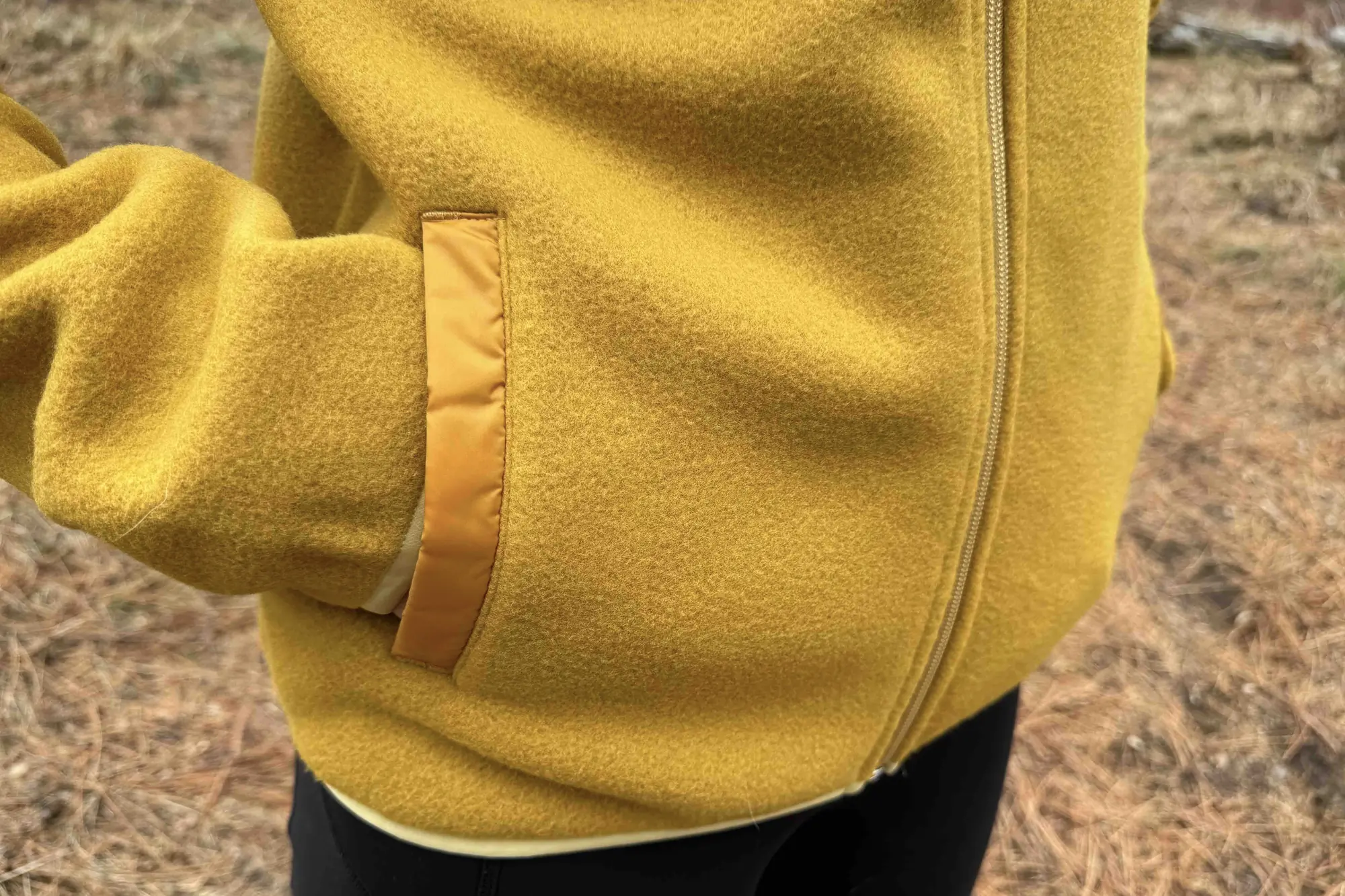



Breathability
If you’re going to be running, skiing, biking, or generally moving in your fleece, breathability is essential.
Fleece is typically made with materials that are designed to draw or “wick” moisture away from the body. Light or midweight layers are best for active pursuits. The dense fabric of heavyweight fleece tends to be less breathable and agile.
Among our winners for the breathability category is the Patagonia R1 Air Full-Zip Hoody, which is constructed with a unique zigzag pattern that combines breathable channels with lofty fleece. These channels let heat escape from areas where you are likely to sweat the most, but they offer little respite from the wind.
Another choice with excellent aeration but heat-holding power is the Norrøna Falketind Alpha 120 Zip Fleece.
Other fleece designs even integrate wool fibers for odor control while keeping your warmth in.
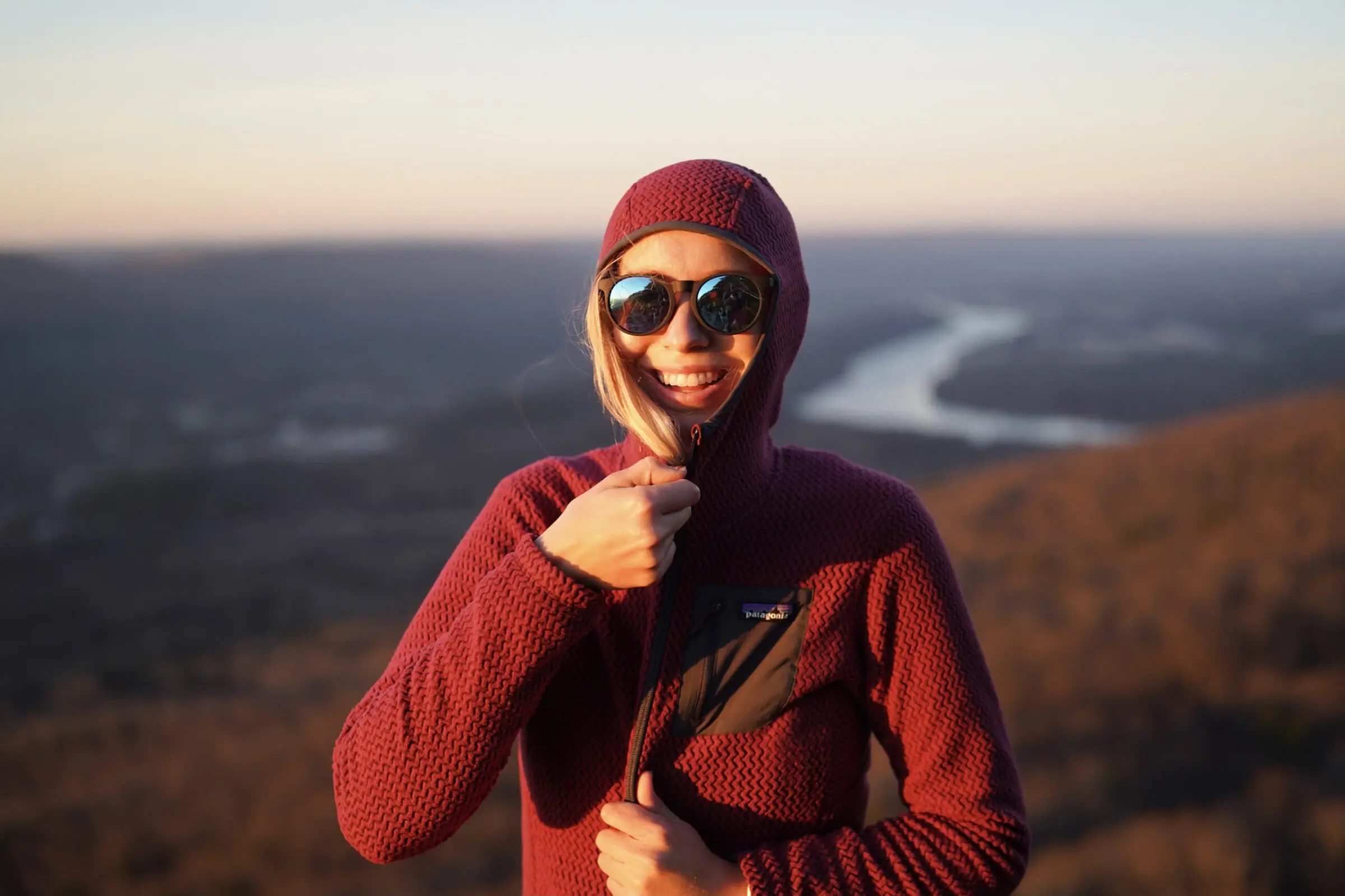



Packability
You’ll want to think about your fleece jacket’s intended use when considering what to buy and bring for different activities. Some of the fleece jackets on this list are streamlined, meant to offer warmth in a thin package that’s perfect for stuffing into a backpack as temperatures shift or layering on and off during ski tours. We found lightweight fleece, like the Norrøna senja warm1 Hood, packs down super small, even stuffing into our running vest and mountain biking hip pack.
Others, especially those in the high-pile fleece category, don’t fold nicely into a small size. Since the material is often warmer and bulkier than other polyester fleece, it’s best when packability isn’t a concern — think car camping.
Durability
A good fleece jacket needs to stand the test of time. Some additional design details help these midlayers do just that. Elbow patches offer reinforcement to lessen wear and tear in the elbow area.
Tasian nylon fabric adds durability. We also like some designs that have nylon panels on the chest, arms, and across the shoulders like The North Face Retro Denali Jacket. Adding a tough material helps prevent abrasion where backpack straps might rub. The prAna Polar Escape Snap Jacket has nylon on the shoulders and back too, always a nice touch.
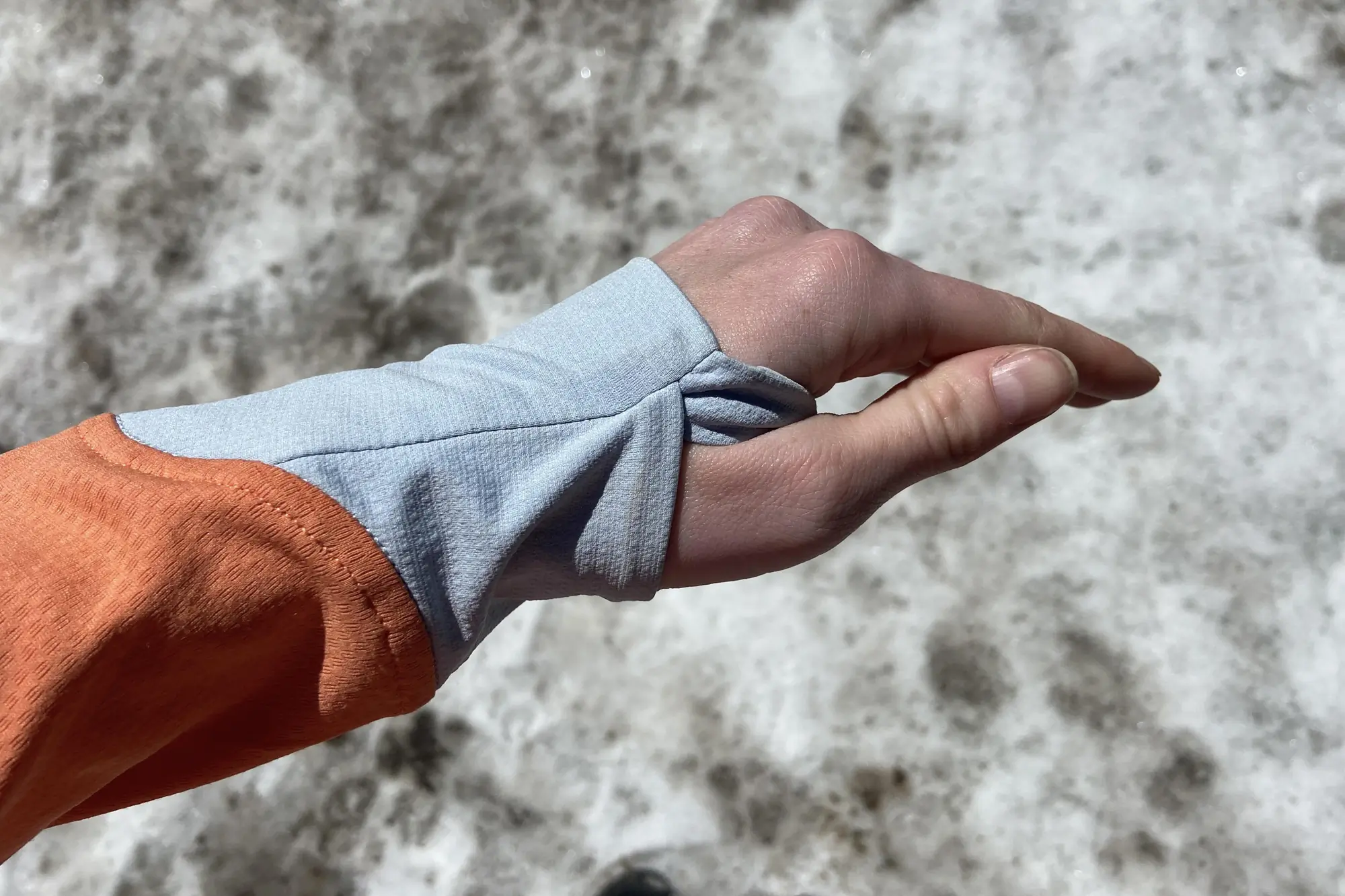



Thumb Loops
Thumb loops, also known as thumbholes, are small openings directly underneath a shirt’s cuffs at the end of the sleeves. A shirt cuff is a layer of fabric that demarcates the edge of a garment at the wrist, and is made up of an additional piece of fabric that’s sewn on to help prevent fraying and increase comfort.
The lengths and elasticity of sleeves and cuffs can vary. Some sleeves are meant to go up to your knuckles and cover your palms, and include thumb loops to facilitate. Thumb loops are often found on fleece meant for athletic activities that are a thinner, flatter material. Bulkier, high-pile fleece, and fleece meant to be worn as an outer layer often go with traditional cuffs rather than thumb loops.
We love thumb loops for fleece worn during athletic activities when layering without bunching is helpful, or when we don’t want the elements getting up our sleeves. Well-designed thumb loops can keep the arms of fleece jackets in place while doing farm chores, and kept wind from getting in on gusty testing days. Other thumb loop designs, like ones that are a thin string of fabric, can become uncomfortable after long periods of time.
The stretch cuffs on the Patagonia R2 CrossStrata are a solid alternative to keep fabric from getting in the way of your fingers when thumb loops aren’t a feature.
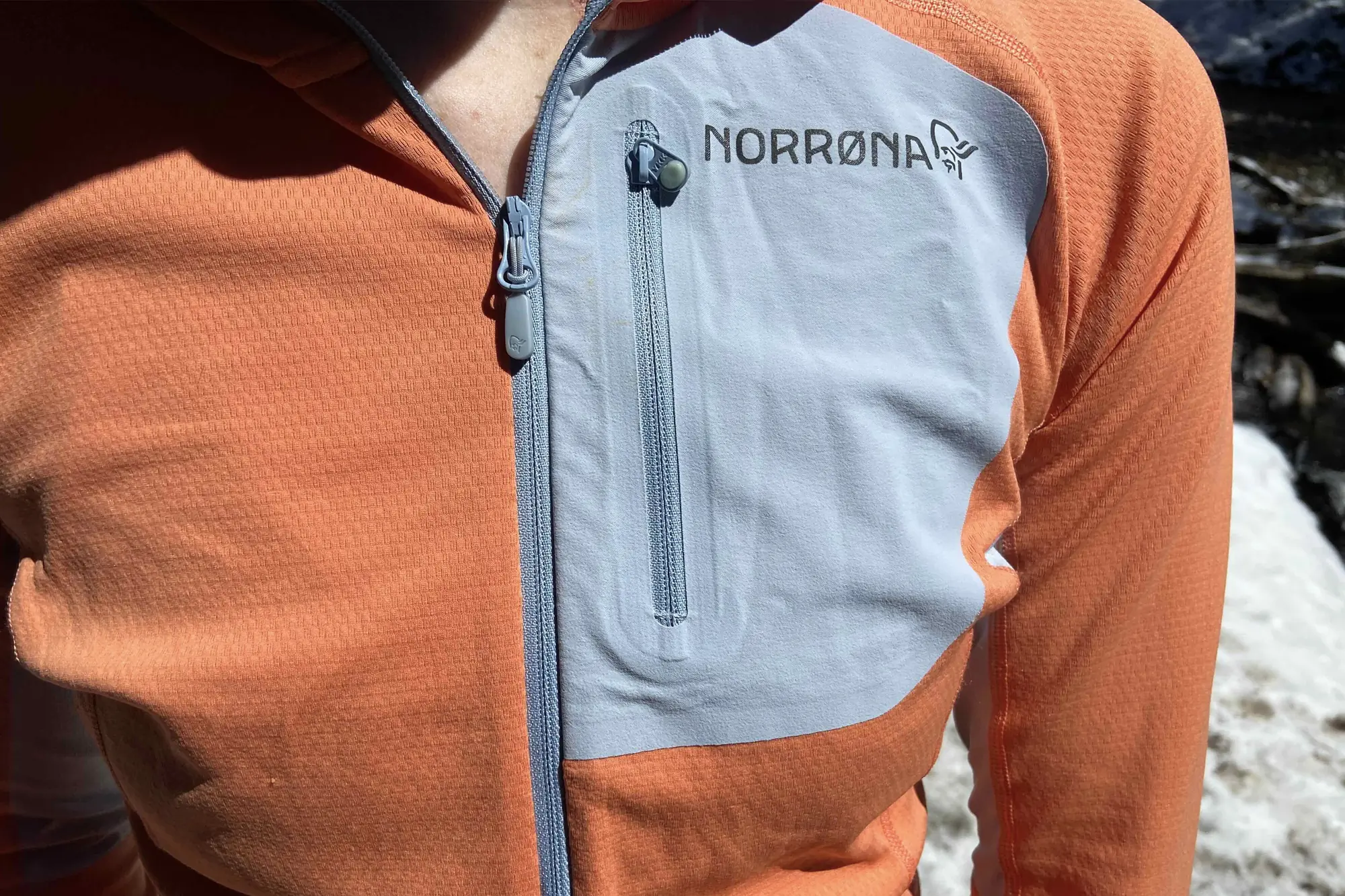



Pockets
Fleece jackets come with all different pocket configurations. How many and where you want them is personal preference.
Zip chest pockets on jackets like the Kari Traa Rothe Midlayer Fleece Jacket or the Patagonia R1 Air Full-Zip Hoody are great for keeping small items like chapstick organized and close by. All full-zip fleece jackets on this list have larger side zip pockets on the lower half of the jacket.
Other types of pockets to look for in fleece are kangaroo pockets — open on both sides to fit both hands — and inner zip pockets for items you don’t want to lose and don’t anticipate taking in and out, like a car key. If you’re going to wear a harness with your fleece, make sure pockets sit higher so they’re still accessible.
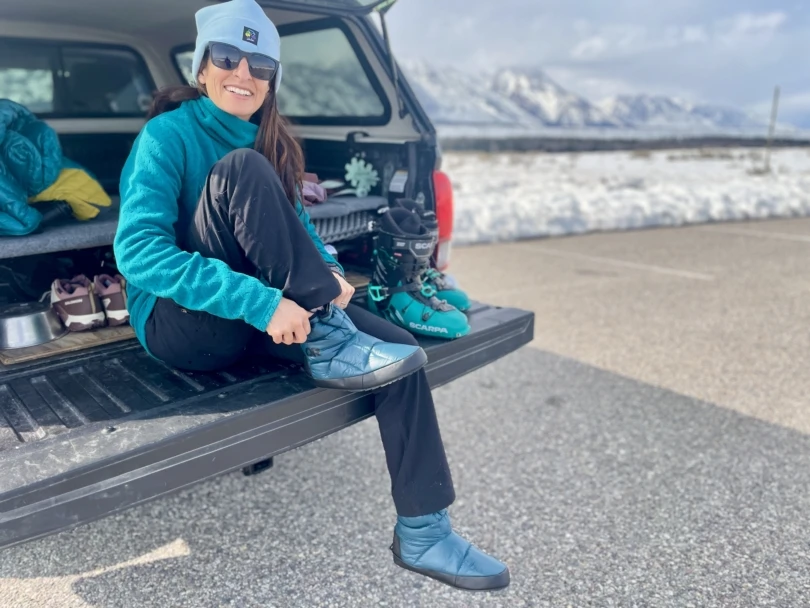



Hoods & Collars
Think about your intended activities when choosing fleece with a hood versus a collar. Hoods are ideal if inclement weather pops up, so a good feature for something you plan on wearing without another shell or layer on top. Slim-fitting hoods can fit under some helmets, while roomier cuts can stretch on top.
But if all of your layers are hooded, those hoods can pile up. Think about how a fleece factors into your existing base layers, puffy, and other jackets. Learn more about down jackets (with and without hoods) in our buyer’s guide.
Collars are great for keeping wind out and sun off your skin, especially when they’re fully zipped up. They can add warmth and hug-like comfort without the bulk of a hood. If it’s not cold enough for a hood, or you have a hat to wear, a hood won’t be needed and a collar does enough. A collar is especially appreciated on midlayers that you’d like to stack next to layers with a hood.
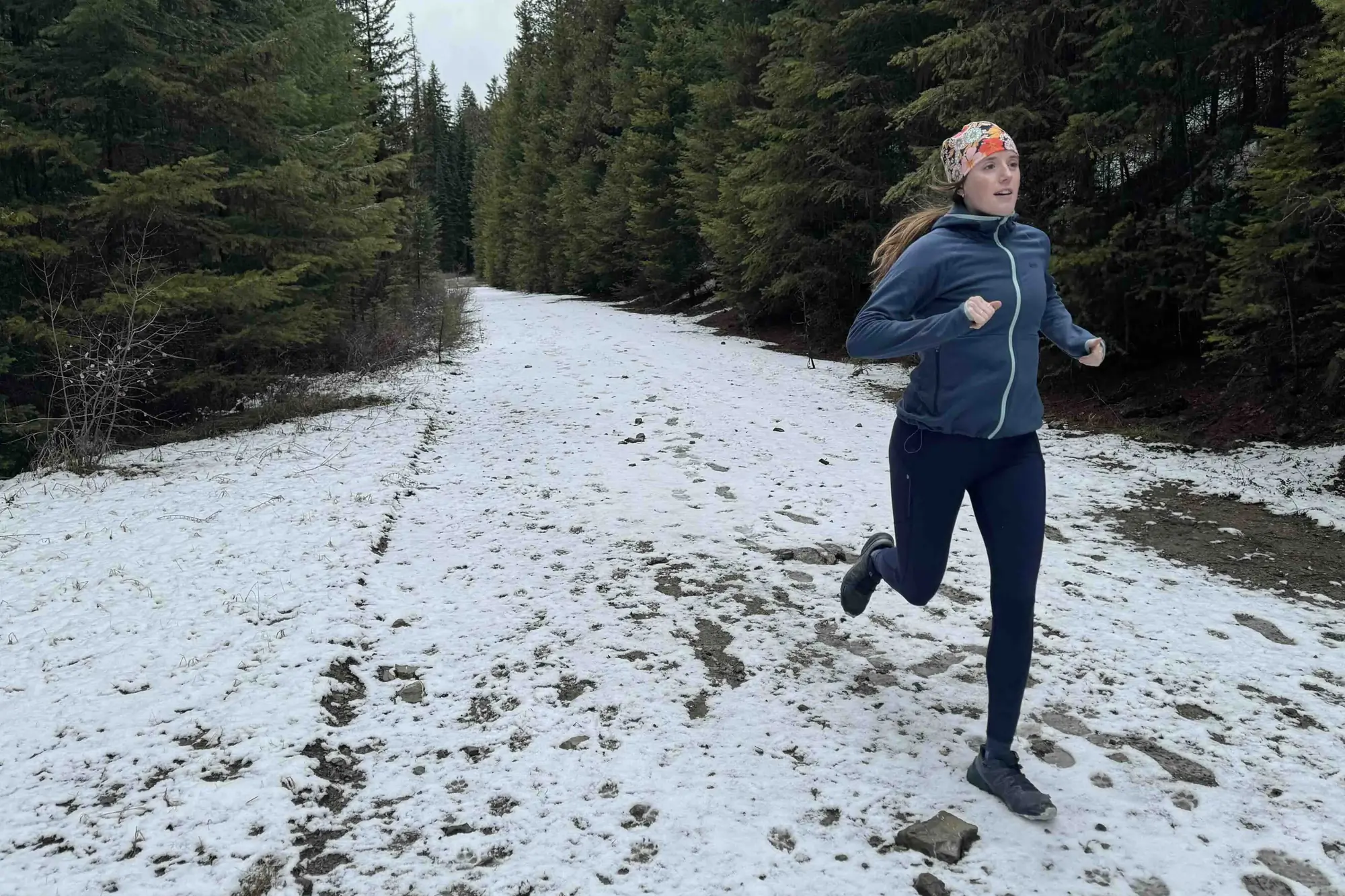



Size & Fit
Women’s-specific fleece jackets consider the shape of the female body, including the hips, chest, and shoulders, as well as the length and width of the torso.
Many of the athletic-fit fleeces we tested are also tailored and gusseted in the arms and shoulders to be more form-fitting yet allow a range of movement. We especially liked the curved hem fit on the Stio Turpin Fleece Half Zip.
Alternatively, there are also plenty of relaxed-fit fleece jackets for women on the market. One of our favorites for everyday wear is the The North Face Retro Denali Jacket.
Sustainability
Recycling
A trade-in program is a great way to keep waste out of the supply chain if you’re itching for something new. Patagonia’s Worn Wear program and Arc’teryx’s ReGEAR programs allow consumers to trade in and buy used gear. REI members can also trade in gear for a gift card.
Some materials are partially or fully recycled. The Stio Turpin Fleece Half Zip is made up of 65% Repreve Recycled Polyester from post-consumer water bottles. The polyester in the Patagonia Better Sweater Hoody is also recycled. According to Patagonia, recycled polyester now costs roughly the same as its virgin counterpart, making the switch easier. The recycled materials often stem from sources like plastic bottles, cafeteria trays, and old clothing.
Patagonia also uses some recycled wool in its fleece. The wool comes from factory scraps and returned garments, which are then mechanically shredded and re-spun into new yarn. Recycled wool is often combined with recycled polyester to increase strength and durability. In the spring of 2023, 9% of the company’s wool products were made with recycled wool.
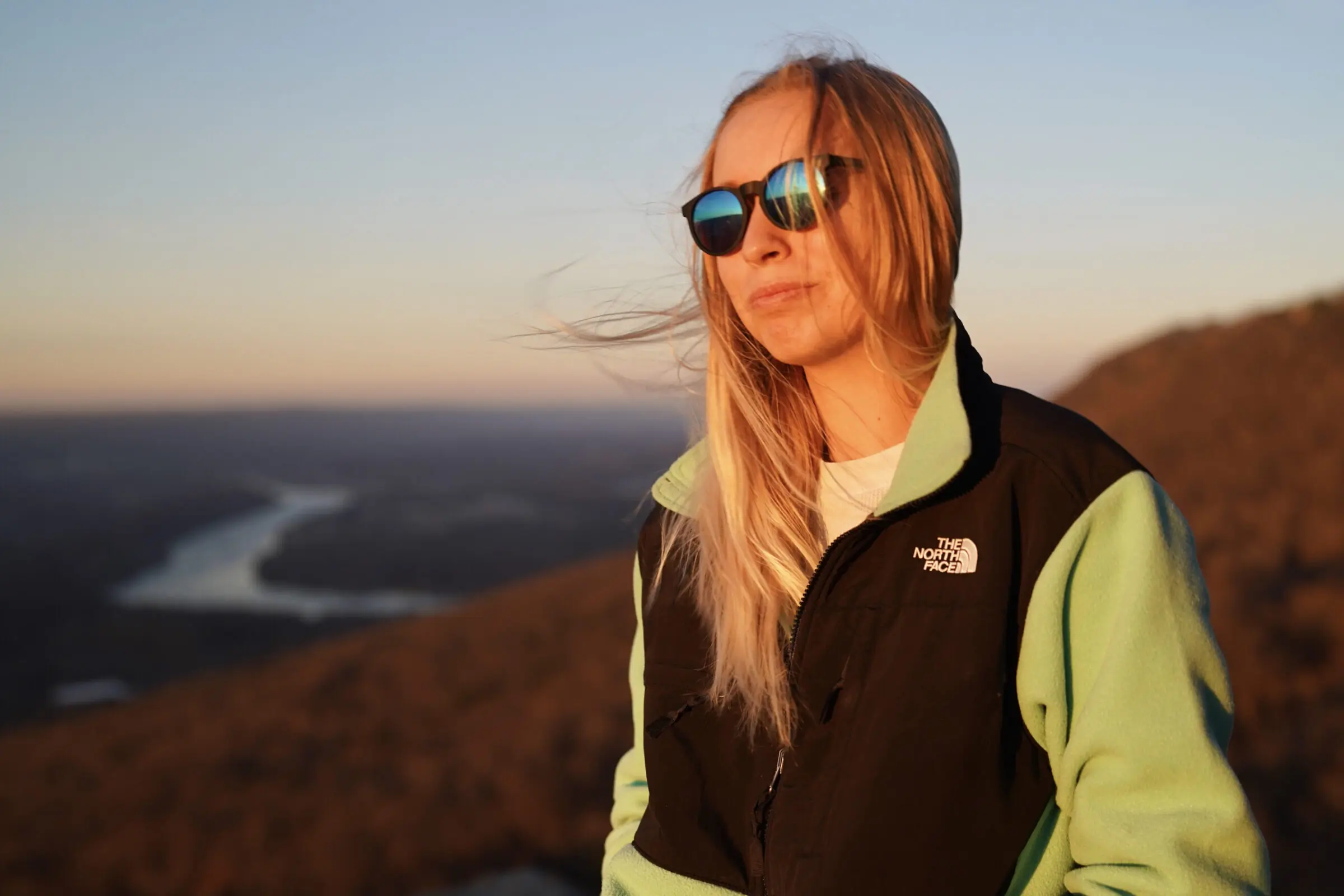



Bluesign & Oeko-Tex
Some jackets, like the Arc’teryx Kyanite Hoodie and the Helly Hansen Daybreaker Fleece Jacket are made with fabrics that meet the criteria of Bluesign, an organization that works to keep chemicals out of the supply chain for the health of humans, wildlife, natural resources, and the earth. Factories approved by the group must meet standards for pollution control and safety protections for workers. Products can meet those standards partially or as a whole, which is identified in labels and online descriptions.
The Jones Snowboards Women’s Flagship Recycled Grid Fleece Pullover also meets Oeko-Tex standards, which means the textiles and fabrics are certified free of chemicals that are harmful to human health.
Climate Neutral
Companies are also taking matters into their own hands. Patagonia is renowned for its environmental activism. The brand supports more than 1,000 groups that support a range of initiatives from biodiversity loss to climate action and also has a self-imposed “Earth Tax” called 1% for the Planet. Smaller companies such as Stio are third-party certified climate neutral, and work to reduce offset by investing in comparable renewable energy.
Microplastics
Unfortunately, fleece jackets are a major source of microplastics: tiny (under 5 mm in length) pieces of plastic debris that come from the breakdown of consumer products. Microplastics end up in the environment, from the depths of the ocean to our bloodstreams. One study found that a single fleece garment can shed up to 250,000 microfibers in a single wash.
So what can be done? First, hold onto your fleece as long as possible. Pick something that you’ll like for years to come and that will hold up for the activities you plan to wear it during.
Also, try to wash your fleece as little as possible, as washing encourages the shedding of microplastics into your local water supply. You probably don’t need to wash your fleece very frequently, especially if you aren’t sweating in it. If you get dirt or a stain on your jacket, try a spot treatment rather than throwing the whole jacket in the laundry. If you do need to wash it, consider installing a filter on your washing machine that catches microfibers and microplastics.
How to Mend
Agh! You’ve ripped your fleece on an errant branch or sharp ski edge. No need to fret.
Some brands have services for fixing apparel. Patagonia’s repair program will take your clothing and repair it for you, within reason. Make sure to check their list to know if your gear fits the bill (nothing extensively damaged or threadbare, for example).
We’ve also had luck with The North Face’s repair program for a broken zipper on a ski shell. But keep in mind some brand repairs can take two or more months, depending on demand. A nearby seamstress might have a shorter waiting list.


Price & Value
If a wool fleece includes cashmere, a super-soft and fine goat hair, its price increases considerably.
Otherwise, the majority of fleece and wool falls in a similar price range, plus a handful of budget-friendlier fleece options.
Budget
The most economical choices in our guide are below $100. The cheapest option is the Helly Hansen Daybreaker Fleece Jacket ($80). The Stio Turpin Fleece Half Zip ($89) comes in at just under a hundo. If you’re looking for a midlayer that provides warmth first and foremost, a roughly $100 option will give you everything you need and nothing that you don’t.
Mid-Tier
At a moderate price, the majority of our favorite fleeces are between $100 and $200. This step up in prices includes more complex fabric mixtures — sometimes with nylon ripstop for durability, UPF fabric to provide sun protection, or a DWR coating to help barricade the elements — as well as jackets with more features like zippered pockets, thumbholes, and hoods.
That collection includes options like the Kari Traa Rothe Midlayer Fleece Jacket ($100), Cotopaxi Teca Fleece Full-Zip Jacket ($120), Jones Snowboards Women’s Flagship Recycled Grid Fleece Pullover ($130), and the Patagonia Better Sweater Hoody ($159).
Premium
Pricier fleece jackets that rank high on our list exceed $200. These higher-end jackets are geared for more technical adventures where weather resistance and breathability are essential, and in some cases, also include pricier sustainable fabrics like wool. Those tags include the Norrøna Falketind Alpha 120 ($219), Arc’teryx Kyanite Hoodie ($200), and Patagonia R2 CrossStrata ($199).
Frequently Asked Questions
Fleece is an insulating midlayer or lightweight outer jacket.
Across countless brands, their fleece blends are each unique and created from synthetic materials, typically polyester or a polyester blend. The human-made fabric is soft, breathable, and quick-drying. It imitates wool fleece.
These jackets are long-sleeved, often with a full or partial front zipper. The material needs an additional exterior treatment in order to be wind- or water-resistant.
The blend is not to be confused with wool fleece, a natural fiber used to create apparel. Wool fleece is sourced from a variety of animals including sheep, alpacas, goats, and bison.
Fleece jackets are a key insulating midlayer for cooler and cold seasons or when the temperatures drop each evening.
As a midlayer, a fleece is a solid addition beneath a snow or rain jacket. Typically, they fit well over a trim synthetic T-shirt — especially if you tend to run hot — or a thinner long-sleeve base layer.
These jackets can be breathable and moisture-wicking for high-output activities like hiking, biking, running, skiing, and snowboarding at the resort or in the backcountry.
If the temperature or environmental conditions are fickle, a fleece treated with additional weather protection — like the wind-blocking Patagonia R2 CrossStrata — can help protect against gusts or snowfall while skinning uphill or traversing a ridgeline.
The density and thickness of fleece vary. You’ll need to consider the temperature range of your environment, how cardio-intensive your activity is, and your personal health needs.
Check out our insulation and weight section above to learn more about fleece weights.
A fleece jacket is an excellent midlayer for cold temperatures and wintry weather. Many fleeces are designed with an athletic, slender fit to pair beneath a snow jacket. Fleece also offers great crossover in the fall, spring, and summer seasons.
Some designs are roomy. Others have a fluffier surface called pile, which is also known as high-pile, high-loft, sherpa, or faux shearling. Pile fleece can still be technical, but it’s generally bulkier. Some recreationists don’t prefer thicker fleece if they’re traveling far and limited on backpack space.
Designs without a fabric treatment to guard against wind or snow work well for dry, cold, sunny, and cloudy conditions.
A handful of technical fleece jackets are constructed to withstand wind and snow and even drizzle or rain. They won’t replace the protection of an outer layer, like a rain jacket or ski shell. But they are great for high-output activities like climbing, backcountry skiing, and splitboarding when extra protection and functionality counts.
The warmth of a fleece jacket varies based on the material’s density, which is measured in grams per square meter (gsm). This can range from lightweight layers that are great for high-aerobic activities to heavyweight jackets perfect for layering up at the campsite.
For more details, check out our section on warmth and insulation above.
In a word, yes, fleece is better than cotton — if we’re talking about managing precipitation, turbulent weather conditions, perspiration, and overall safety during outdoor activity.
Though some folks enjoy the touch of cotton, fleece is a hydrophobic fiber that repels water and dries relatively fast. Cotton absorbs moisture, doesn’t dry quickly, and can chafe when wet.
Recreationists should avoid fabric that holds sweat and stays damp, which can potentially increase the risk of hypothermia and discomfort.
Fleece attracts dust, lint, pet hair and more. But, good news! Fleece jackets are generally safe to be washed in a washing machine. Turn the jacket inside out to reduce pilling (which may happen over time as is) and wash on its own.
Cool water and a gentle cycle are good ideas, too. Be careful drying for too long or on too high of heat, and if your fleece is matted, a soft-bristle brush can help fluff. Always check the tag on your garment for more specifics. Launder your fleece sparingly, as microplastics from the jacket can get into waterways when washed.
It can! Fibers fall out in every wash, which reduces a jacket’s insulating ability.
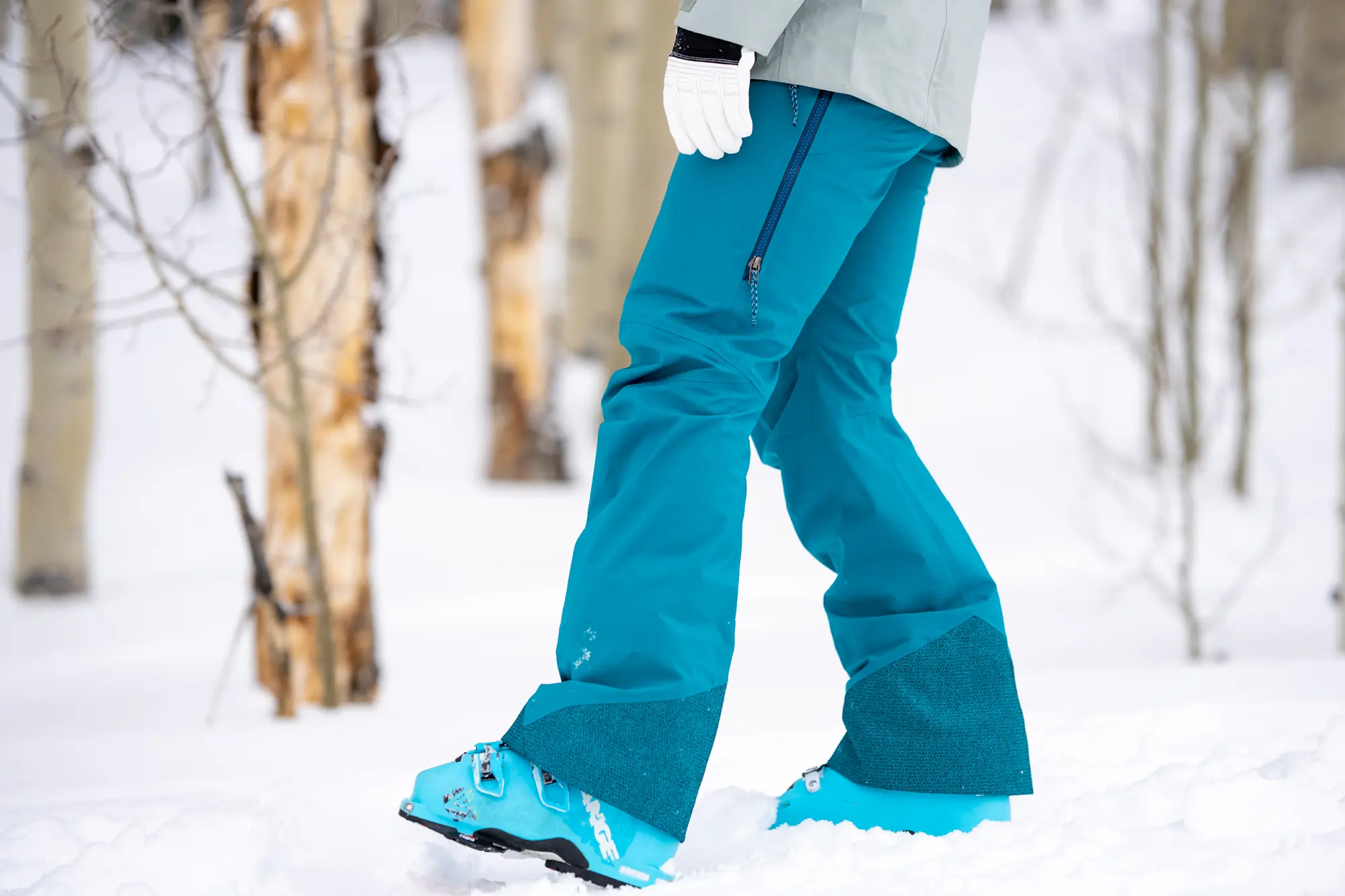

The Best Women’s Ski Pants of 2025-2026
We tested the best women’s ski pants for the resort and backcountry including our top picks from Rab, The North Face, Arc’teryx, and more.
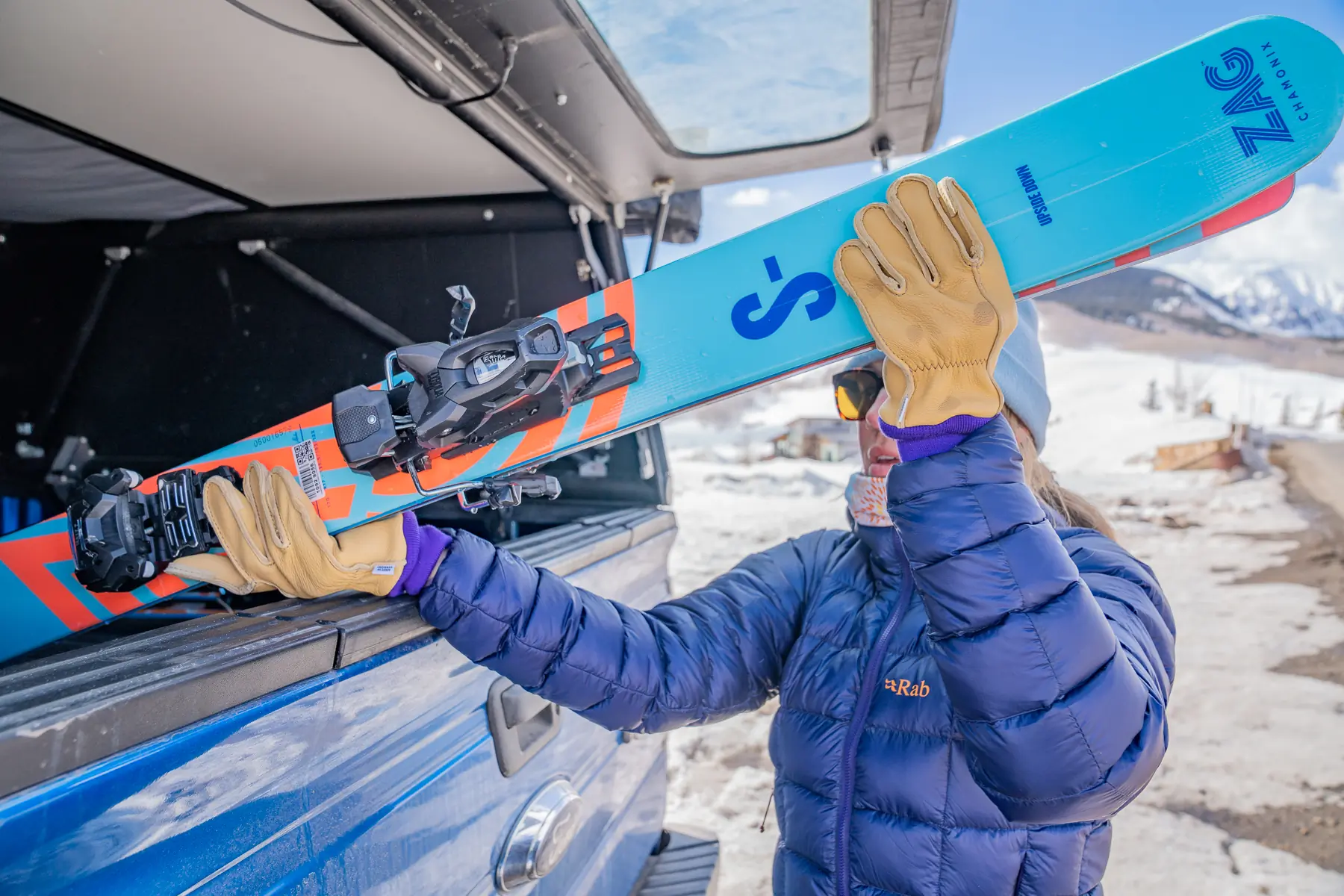

The Best Winter Gloves of 2025
From light coverage to heavy insulation, we tested the best winter gloves for cold-weather activity including options from Hestra, Black Diamond, Dakine and more.

